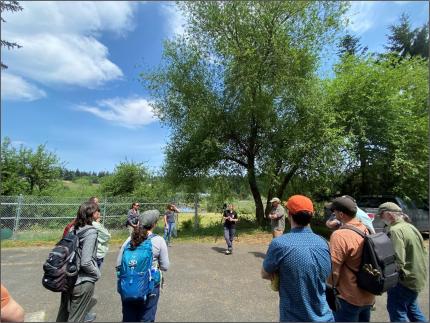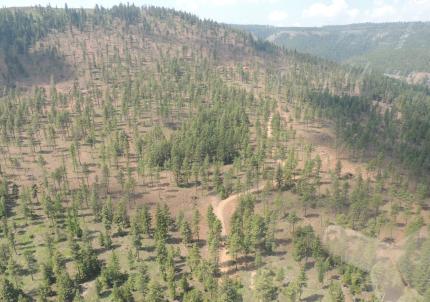
Wildlife Program report: May 16-31, 2023
Providing Recreation Opportunities
The forest health team is providing firewood cutting opportunities in Colockum Phase 1, Unit 1 area, via permit only. Permittees will be allowed to cut up to five cords per person.
Conserving Natural Landscapes
Range Ecologist Burnham prepared for monitoring the Department of Natural Resources grazing lease in the Teanaway. Burnham prepared maps, photos, and equipment for other grazing sites and met with WDFW staff members and grazing permittees in the Simcoe Mountains Unit.
Prescribed Fire Program Manager Eberlein continued working with the Department of Natural Resources and U.S. Forest Service regarding fire activities, following Legislature intent for better coordination and combined efforts.
Prescribed Fire Program Manager Eberlein participated in the Yakima Community Wildfire Protection Plan. The near complete draft of the plan includes prescribed fire actions for the next eight years.
Prescribed Fire Program Manager Eberlein negotiated to add the Prescribed Burn Program team to the Department of Natural Resources (DNR) coordinated emergency dispatch centers in northeast and central Washington. DNR has agreed to provide 24-hour safety support and communications for burning projects. The service will be provided for free for a period of at least one year to evaluate how much WDFW will use the dispatch support. There will be a future agreement after the evaluation.
Colockum Phase 1 thinning is underway. Work is expected to continue until mid-October.

Scatter Creek thinning to restore oak savannah is complete. While work with Washington DNR to showcase this project via video did not happen, we are seeking other ways to get the word out on this amazing work that supports pollinators, rare prairie ecosystem in the Puget Sound trough, and demonstrates a close partnership with WDFW Cultural Resources team and the Chehalis Tribe.
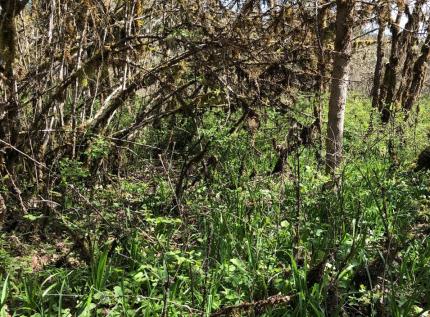
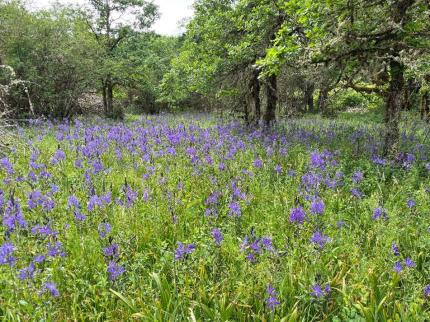
Conducting Business Operations and Policy
Lands Division is hiring for multiple positions. The prescribe burn team hired two planning positions and one operations position. A range biologist position did not hire in first round but reopened for a second round. There is a forester hire underway. Some weed control crews are hiring and some have hired.
Managing Wildlife Populations
Sharp-tailed Grouse: Biologists Atamian, Lowe, and Brinkman set and monitored traps on a sharp-tailed grouse lek in Lincoln County to capture and deploy a GPS transmitter on an adult male bird. This grouse will be used to monitor locations and movements and will hopefully assist us in identifying winter habitat being utilized by other sharp-tailed grouse in this region.
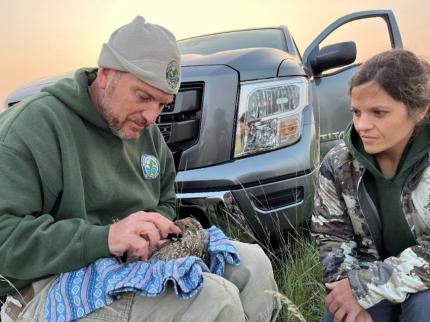
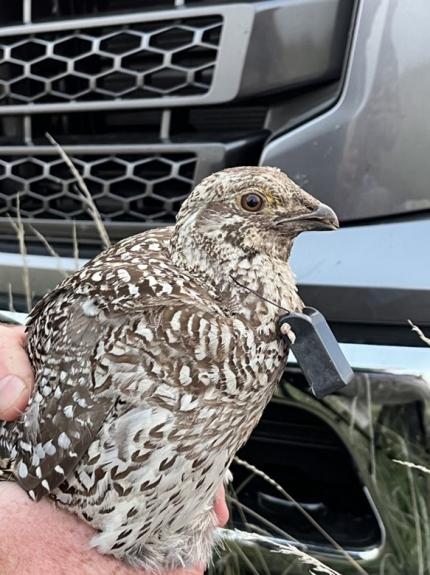
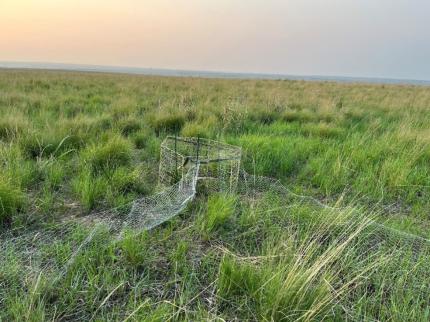
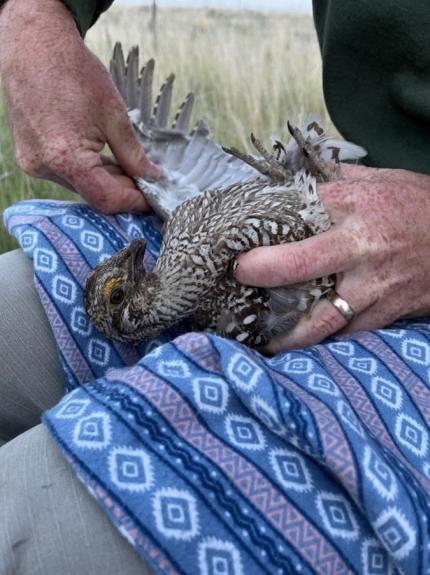
Elk Fence: Natural Resource Worker Jensen and Natural Resource Technician Tritt checked the elk fence between Bakers Pond and Stevens Ridge. They found a tree over the fence and two holes in the fence. Everything was repaired. While they were up on Mountain Road, they checked the elk fence north of Bakers Pond.
Chronic Wasting Disease: Natural Resource Technician Nizer sampled a whitetail deer in Unit 142 for Chronic Wasting Disease (CWD). The deer was roadkill that died on Highway 195. The deer is one of three roadkills in the last week, probably due to deer moving around more during the early summer months. The deer was sampled and then taken to the Pullman Department of Transportation pit where it will decay.
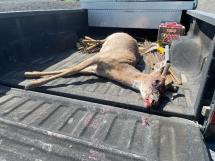
Chronic Wasting Disease Operations: Natural Resource Technician Heitstuman checked local pits for CWD samples. The text tree system for getting the closest employee to recover a sample is working well.
Wildlife Conflict Specialist Kolb collected CWD samples at roadkill pits at the request of Assistant District Biologist Vekasy who was tied up with elk calf captures.
Natural Resource Technician Nizer sampled a mule deer doe that was hit on Highway 195 and was dropped off at the Colfax Department of Transportation pit. Roadkill deer are starting to become more prominent during these warmer months. Sampling will continue throughout the summer months leading up to deer season.
Grizzly Bear Rub Posts: Biologist Turnock checked rub posts in Pend Oreille County for grizzly bear hair. A few samples were likely grizzly bear and will be sent in as part of the U. S. Fish and Wildlife Service (USFWS) monitoring program within the Selkirk Recovery Zone.
Providing Recreation Opportunities
Mica Peak Hunt by Reservation Only: Private Lands Biologist Gaston spoke with the director of Spokane County Parks, Recreation, and Golf to discuss renewing the Hunt by Reservation Only Program contract for Mica Peak Conservation Area. A meeting later in June will be needed to discuss additional details about the project.
Hunt by Written Permission Property: Natural Resource Technician Nizer coordinated with a local gravel company to drop off gravel for a new parking spot at a Hunt by Written Permission property.

Waikiki Springs Volunteer Project: Access Manager Dziekan worked with the Inland Northwest Land Council (INLC) to recruit volunteers. They held a volunteer trash pick-up day at Waikiki Springs this past weekend. Dziekan had nine volunteers show up that walked the switchbacks and into the bushes to gather any litter that was left since the last volunteer work party a few years ago. Dziekan was very happy to report that the volunteers had almost no success finding litter. Over the two hours they scoured the hillside, a grand total of one trash bag was collected. Dziekan doesn’t know what exactly changed, but the property was spotless. Dziekan couldn’t be more pleased that the volunteers had nothing to do.
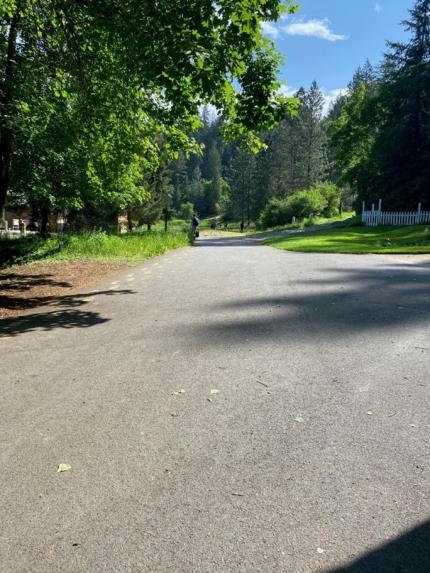
Coordination: Private Lands Biologist Hadley coordinated with members of the Blue Mountain Pheasants Forever and an employee of the Walla Walla Conservation District to discuss working as collaborating agencies and volunteer groups. Their goals include enhancing existing habitat by identifying property landowner objectives and criteria including funding sources, site preparation, seeding specification operation and maintenance.
Providing Conflict Prevention and Education
Camp Reed: Wildlife Biologists Prince and Turnock each provided one day of outreach to Spokane County Odyssey Program students. The biologists talked to the students about bear biology, bear identification, and bear safety. The students got to end their lesson by practicing with inert bear spray.
Asotin County Commissioners Meeting: Wildlife Conflict Specialist Wade attended an Asotin County Commissioner meeting where Wildlife Conflict Supervisor McCanna and Wolf Biologist Spence answered questions from the public in attendance.
United States Air Force Training School Bear Spray Presentation: Wildlife Biologists Prince and Turnock provided the head trainer of the United States Air Force Survival Training Program the presentation on bear spray and staying safe in bear country. The trainer will take our presentation and deliver the information to trainers as they rotate through the Survival Training Program.
Conserving Natural Landscapes
Wildlife Habitat and Water Guzzlers: Natural Resource Technician Heitstuman spent three days on the Swanson Lakes Wildlife Area performing field preparation work, planting food plots, and moving equipment from other areas as needed. This was an opportunity to share skills and provided an opportunity to learn how things are done differently across the state. Private Lands Biologist Baarstad was instrumental in the work and in showing the different habitats and wildlife in the area.
Photo Points: Biologists Brinkman and Lowe began taking pictures at a series of photo points in Lincoln County to document current habitat conditions and compare them with similar photos taken at those sites in previous years.
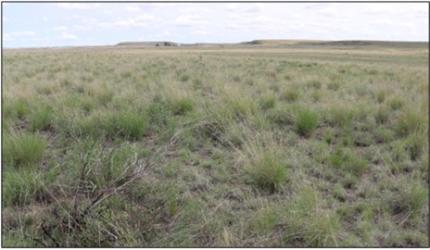
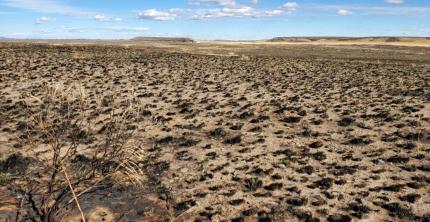
Revere Wildlife Area Inspection: This week Wildlife Area Manager Finch and Natural Resource Technician Wagner went to the Revere Wildlife Area so Finch could go over all the pending projects with Wagner. They inspected the shrub plots that were planted on the Revere Wildlife Area on April 1 and April 2 by Pheasant Forever and other volunteers. There were 25 enclosed shrub plots planted and out of over 750 shrubs only two small shrubs appeared to be struggling. When the new Swanson Lakes, Revere, and Reardan Audubon Assistant Manager Rimmelspacher starts work on June 5, Wagner will be able to show Rimmelspacher the wildlife areas and go over each individual project.
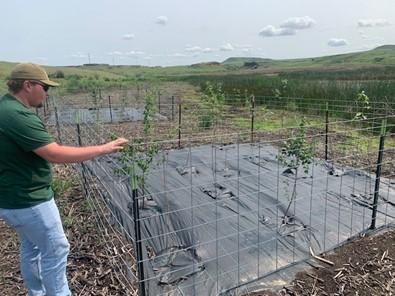
Asotin Creek Wildlife Area Spraying: Woodall and Rimmelspacher spent quite a bit of time this week spraying agricultural fields at Smoothing Iron Ridge. Blade sprayed fallow fields with the Case 4490 tractor and 50-foot sprayer while Woodall primarily sprayed weeds out of winter wheat fields. They also used one of the 5-ton military trucks with an 1,800-gallon water tank for rapid refills. Having a ready supply of water available made spraying go much faster.
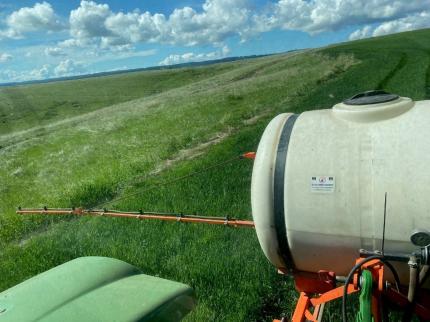
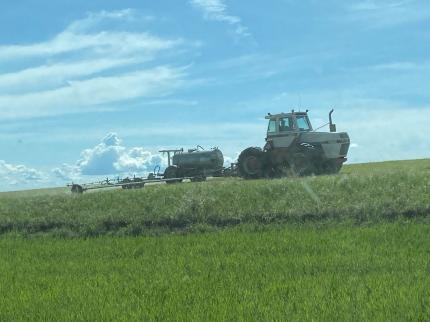
Sandygren Property: This week Wildlife Area Manager Finch, Natural Resource Technician Wagner and Bureau of Land Management Spokane District drove around the parcel that is targeted for restoration to double check the field boundaries. Finch ordered the herbicides and together with Wagner moved and setup the equipment to spray approximately 70 acres for full native grassland restoration. Wagner started spraying the field on Thursday until an electrical issue with the tractor. Wagner drove to the John Deere dealer in Coulee City for a new battery.
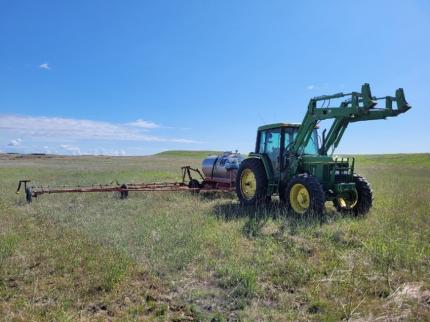
Access Areas District 2: Access Manager Dziekan and Natural Resource Technician Brant worked on several access sites in District 2 this week. Dziekan is busy getting Brant familiar with all the sites and their duties such as weed trimming, litter pickup, toilet cleaning, blowing off asphalt parking areas, and many more chores to help keep the sites clean and presentable.
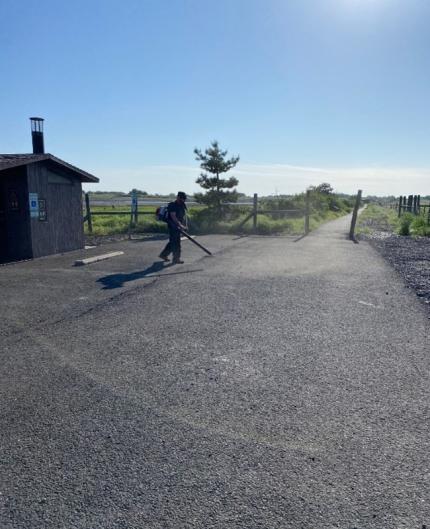
Providing Education and Outreach
Hunter Education: Wildlife Conflict Specialist Kolb assisted with teaching 11 hours of Hunter Education to students in the Walla Walla Valley.
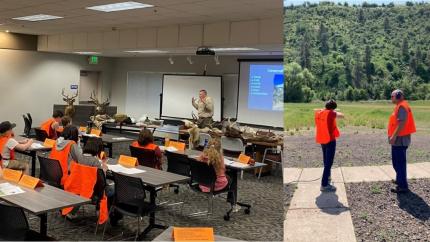
Chief Joseph Wildlife Area Weed Control: Woodall led an outreach event for the Lewis & Clark All-Terrain Vehicle Club with a ride out to Shovel Creek. Former Owner Tippett was present to talk about his family’s history of owning the land and running livestock on the former cattle ranch. They saw elk and deer as well as abundant wildflowers.
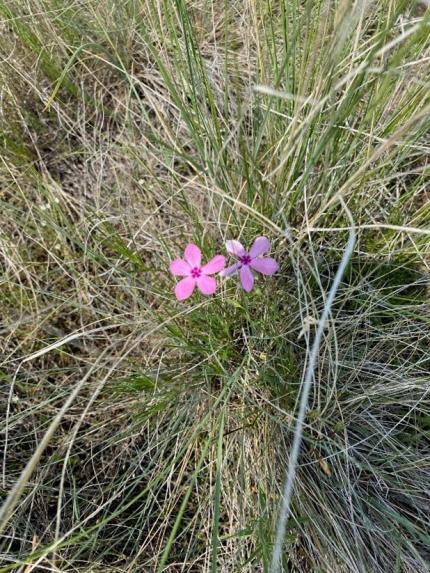
Kids in the Hills: Biologists Lowe and Brinkman participated in the first three days of the annual Kids in the Hills event at Dishman Hills Natural Area, leading classes of 3rd and 4th graders on hikes in the natural area while teaching them about local wildlife. The event will reach nearly 500 students over five days this year.
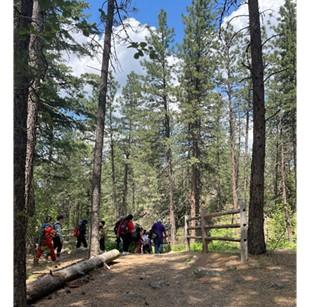
Lake Roosevelt Forum Discovery Zone, Swanson Lakes Wildlife Area: Wildlife Area Manager Finch and Natural Resource Technician Wagner hosted the 2023 Discovery Zone Home on the Range Tour at Swanson Lakes on Wednesday. Wildlife Officer Beauchene came out later to talk to the kids about her job. Towards the end of the tours, while watching Officer Beauchene’s presentation, a thunderstorm with rain and hail came over for about 30 minutes leaving the parking area full of water. The nature walk that was taken earlier was planned perfectly. The tour included a GPS course to teach how to use and find coordinates. Wildlife area staff members had hidden flags and marked them on the GPS for the students to find. Finch showed the kids how the wildlife area personnel use drone technology to search and monitor projects and how to preprogram the drone to fly and measure its own area without the drone pilot flying the actual drone. The kids seemed to be amazed with the autonomous fly program.
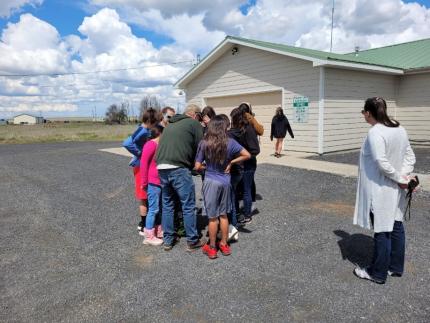
6th Grade Camp at Camp Wooten Environmental Learning Center: Wildlife Area Manager Dingman and Private Lands Biologist Thorne-Hadley spent a day teaching a class about predators and prey to the Dayton, Waitsburg, and Touchet 6th graders at Camp Wooten Environmental Learning Center.
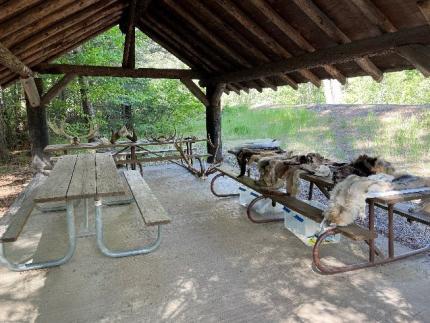
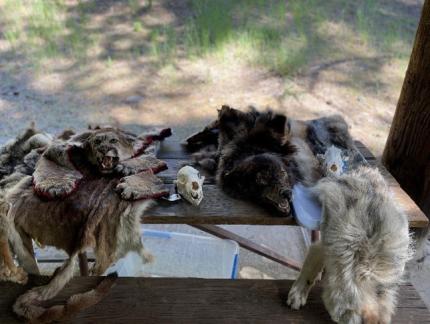
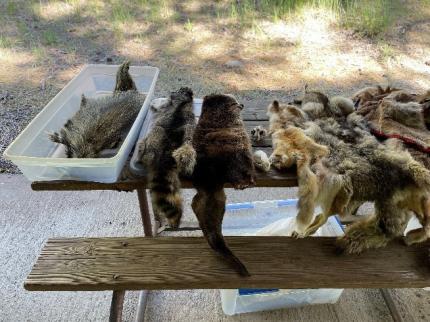
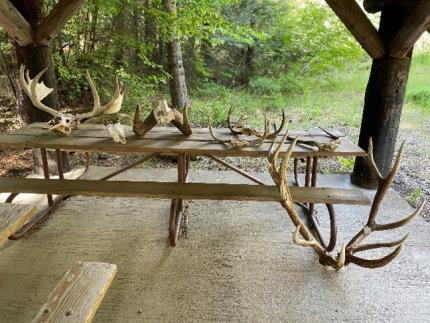
Overflow Parking at Horseshoe Lake: Sherman Creek Wildlife Area Assistant Manager Palmer received a complaint from a resident near Rustlers Gulch Wildlife Area and Horseshoe Lake Access Area, complete with a video recording. The complainant noted that overflow parking for Horseshoe Lake over Memorial Day weekend spilled out onto the county road, causing safety and passage problems. Wildlife area and access area staff members worked with Public Affairs Officer Lehman to publicize the need for vehicles to park off county roads, and if parking areas are full, to find another place to recreate. Lehman provided a brief summary that can be used by local media outlets to get the word out.
Conducting Business Operations and Policy
Kettle River Access Area: Natural Resources Technician Zueger inspected the Kettle River access areas. The south site had been largely under water a couple weeks ago, but with the Kettle River starting to settle down after heavy snow melt, the site is dry again. Both sites’ restrooms appeared to have had little to no use since the last check.
Damage Permit System Meeting: Wildlife Conflict Specialist Wade participated in a Damage Permit System meeting. The outside vendor gave a demonstration of what their program does and how it could be useful for creating and issuing damage and kill permits.
Other
Private Lands and Conflict Land Access: Wildlife Conflict Specialist McCarty held a meeting with Private Lands Biologist Gaston, Private Lands Technician Nizer, Conflict Specialist Earl, District Biologist Lowe, and District Biologist Assistant Brinkman regarding the efforts in place to gain public hunting access on private lands for turkey hunting in northern Spokane County and discussed the opportunity to expand that effort to elk and deer hunting access due to increased damage over the last several years to farmed crops.
Managing Wildlife Populations
Sunnyside Bats: Sunnyside and Snake River wildlife area staff assisted Department of Fish and Wildlife bat biologists, District Wildlife Biologist Fidorra, and others with annual bat sampling at the Sunnyside Headquarters Unit. Bats were collected using a harp trap as they exited their roost box. Once trapped, bats were sampled and banded. It was a late night, but staff members had a great time learning more about the bats and assisting with the sampling.
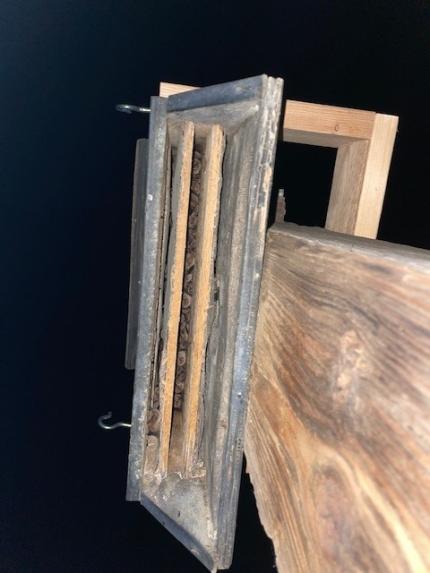
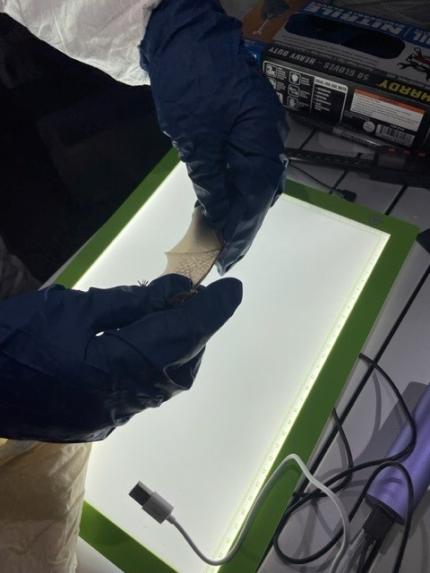
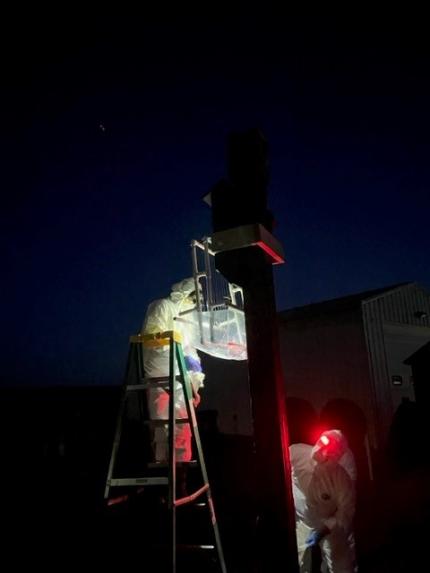
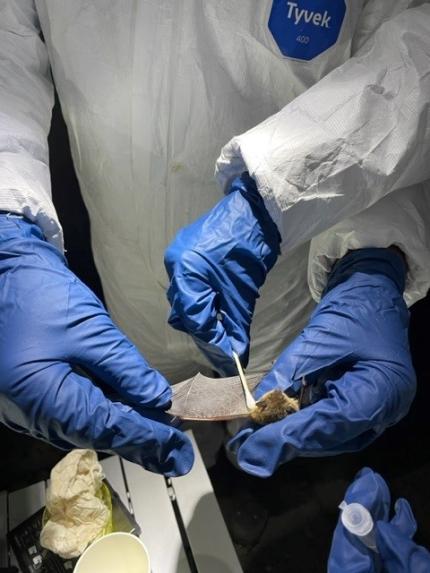
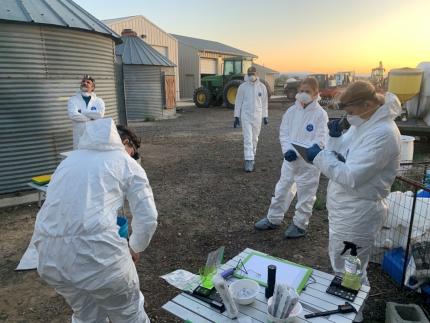
District 8 Bat Surveys: Assistant District Biologist Wampole commenced summer maternity bat roost surveys in Yakima County. Long term monitoring showed an increase in roosting big brown bats at one maternity colony.
District 8 Wolf Sighting: Wolf monitoring within the Naneum Canyon revealed no additional sightings of a previously detected gray wolf.
Burrowing Owl Tracking Study Commences: Species Lead Hayes and District 4 Wildlife Biologist Fidorra worked with partners including the University of Idaho to deploy transmitters on male burrowing owls to study movements and habitat use during the non-breeding season. Many Columbia Basin males have been shown to remain in the state during the winter, unlike other populations of this subspecies. Transmitters will also be deployed in Oregon and British Columbia in this regional study spearheaded by WDFW.
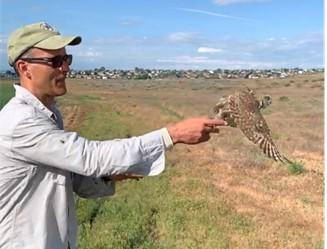
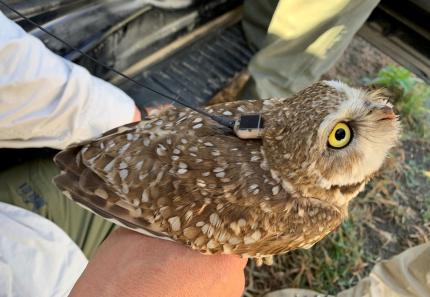
Ground-squirrel Survey Completed: Wildlife Biologist Fidorra and biologists across the Columbia Basin revisited known colony sites for Townsend’s and Washington ground-squirrels this spring. While a few colonies remain, many historic colonies were vacant. Local landowners supported the theory that a recent decline coincided with the harsh late snows of 2017-2018 around Tri-Cities, but long term declines had started long before.
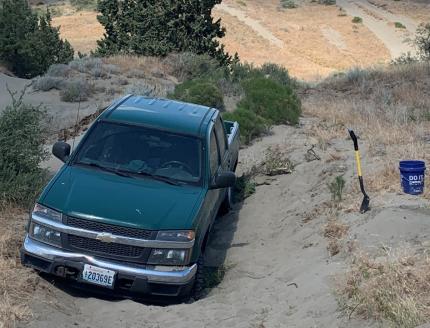
Providing Recreation Opportunities
Unapproved User-Built Bike Jump Removal: Natural Resource Specialist Frame disassembled and removed a total of five unapproved user-built bike jumps on Cheeky-Bugger and Wildcat trails. Some jumps were large and were constructed of fallen logs and rocks. After removal, Frame re-graded the trails back to their original state.
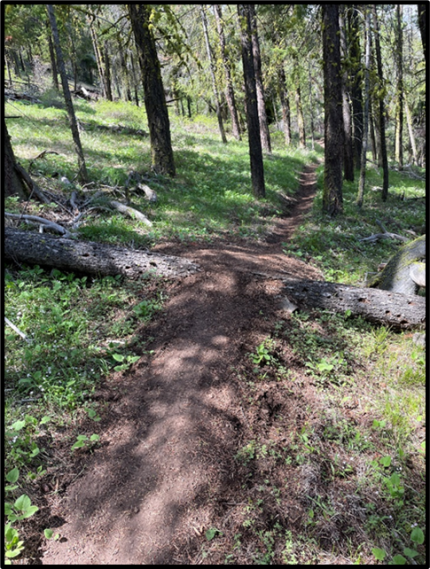
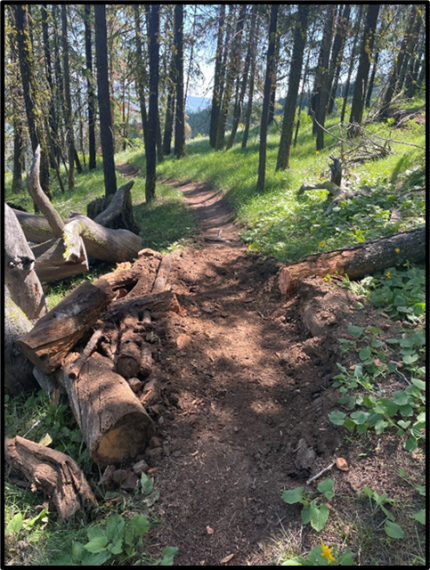
Another Successful Year of the Landowner Hunting Program: Private Lands Biologist Hulett worked with landowners enrolled in the Silver Dollar and Blackrock Landowner Hunting Program to complete and submit their 2023 Landowner Hunting Program report. In total, 21 bull elk and three cow elk were harvested across the six enrolled properties. Along with these landowner tags, 21 state drawn hunters were brought out to the properties for opportunities to harvest elk.
Providing Conflict Prevention and Education
Rattlesnake Hills Elk: Wildlife Conflict Specialist Hand processed and issued additional damage prevention permits to a landowner in elk area 3721. A trail camera was installed on a traditional route elk use to enter wheat fields near the Hanford National Monument. It will monitor elk use and activity.
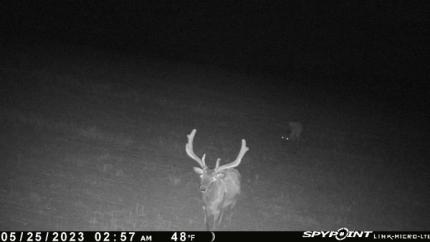
Elk Thermal Imaging: Night-time hazing continues and the use of newly purchased thermal imaging optics have improved the ability to locate animals in crop areas in complete darkness.
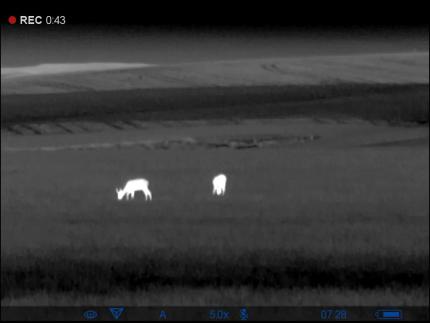
Pasco Rattlesnake Response: Wildlife Conflict Specialist Hand responded to a call in Spillman concerning an aggressive rattlesnake near the Columbia River. Three young teenage individuals abandoned their belongings near where the snake was initially observed. After a search of the area, no snake was located. Their belongings were returned, and education was provided on rattlesnake behavior and avoidance.
Two River’s Park Osprey: Wildlife Conflict Specialist Hand responded to a call concerning an osprey that was observed tangled with fishing line and attached to a tree from the previous day. One osprey was located at the area that was described but it was uninjured and flew away.
Prosser Beaver: Wildlife Conflict Specialist Hand received and responded to a complaint from an orchardist in the Prosser area concerning a beaver that had damaged a few cherry trees. Several preventive techniques were discussed including protective armament around the trees and possible trapping.
Horse Heaven Hill Pronghorn: Wildlife Conflict Specialist Hand and Enforcement Officer Kunz-Pfeiffer responded to a report from local power company staff members that a buck pronghorn antelope had an arrow in it. After contacting the landowner and obtaining permission to access the property, we conducted a search. No signs of the animal were located. We asked the landowner and neighboring landowners to contact us if they see any sign of the animal or scavenging bird activity.
Kahlotus Deer Damage: Wildlife Conflict Specialist Hand completed renewals of two Damage Prevention Cooperative Agreements for landowners in the Kahlotus area to address deer damage in winter wheat crops.
Kittitas County Conflict: Conflict Specialist Wetzel worked with several hay growers who were having problems with elk in crops. Elk have been hazed from irrigated hay, row crops, and at haystacks. Greenup is helping keep elk higher and on public land.
Yakima County Conflict: Conflict Specialist Wetzel worked with several hay growers who were having problems with elk in crops. Elk have been hazed from irrigated hay, row crops, and orchard areas.
Wetzel Cougar: Conflict Specialist Wetzel assisted enforcement with trapping a cougar that killed a chicken and was loitering in a neighborhood. Trapping is ongoing.
I-90 Wolf Vehicle Collision: A dead wolf was recovered after being struck on I-90. The wolf had a tracking collar.
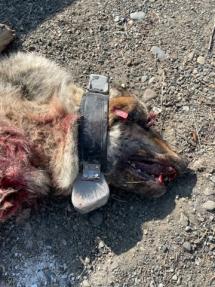
Naches Elk Relocation: An elk was relocated away from a goat pen where it had been living for several months. The elk was an orphan that attached to the goats and had become a nuisance to the livestock owner. Biologists Mackey and Moore relocated the elk to the Little Naches River area.
Conserving Natural Landscapes
L. T. Murray Wildlife Area Weed Control: Natural Resource Technician Blore flew with Central Valley Helicopters to identify heavy weed populations in the 2022 Vantage Highway Fire burn area. Assistant Manager Winegeart hired the helicopter to spray 50 acres of areas identified for whitetop and Russian knapweed. The fire removed most canopy cover from the riparian areas making weed identification and herbicide application easier.
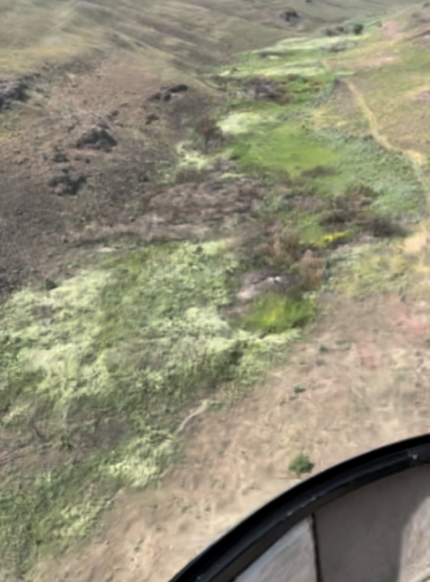
L. T. Murray Riparian Health: Manager Morrison and Assistant Manager Winegeart accompanied some Habitat Program staff to the Whiskey Dick Unit for drone flights which focused on creek banks and possible areas in need habitat enhancement.
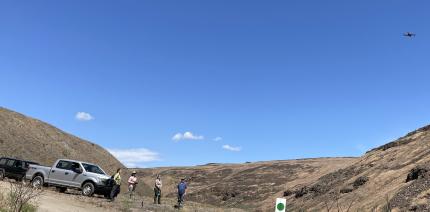
Wenas Wildlife Area Weed Spraying: Biologist Miller, Natural Resource Technician Frame, and Natural Resource Specialist Stoltenow all have been thoroughly covering the wildlife area in search of Scotch thistle, Canada thistle, and whitetop to be sprayed with herbicide. These species are all noxious and invasive weeds that can harm native plants and animals. Much of the spraying is done with backpack sprayers.
Miracle Mile Acquisition or Conservation Easement: Wenas Wildlife Area Manager Hughes, Habitat Biologist Meyer, and Environmental Planner Teske met with a landowner bordering the Wenas Wildlife Area. The landowner is interested in conserving their property either by selling it to WDFW or by putting it into a conservation easement. The three toured the property and took photos displaying the varying forms of habitat that remain on the property. The property includes shrubsteppe habitat leading into areas with ponderosa pine. It also includes a riparian section of North Wenas Creek. Hughes, Meyer and Teske are planning to apply for a grant a couple years from now to help conserve the property. Getting photos and documenting information now is an important step in this process.
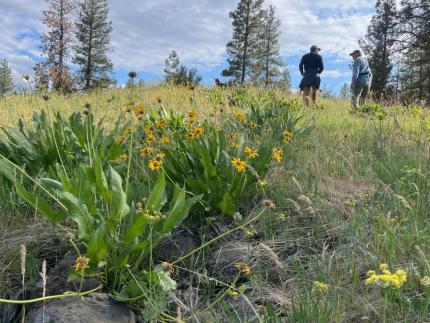
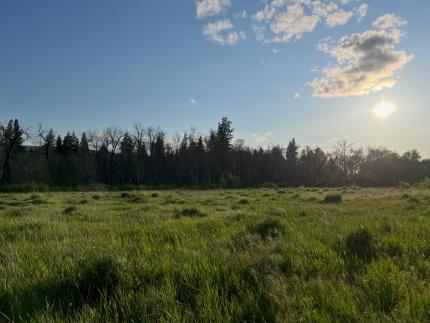
Habitat Projects on Private Lands: Private Lands Biologist Hulett along with Private Lands Technician Manderbach completed all of their spring shrub plantings. In total, 250 additional shrubs were planted on two sites in Yakima County. This brings the total number of shrubs planted in 2023 to 900 across nine sites.
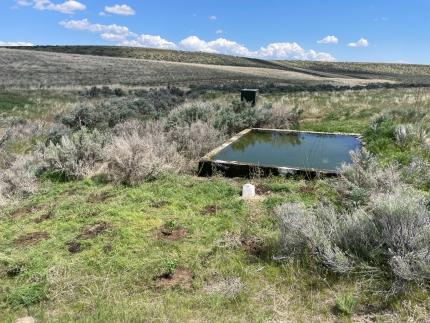
Colockum Wildlife Area Forestry: Work continues on the forest treatment and thinning work on the Colockum Wildlife Area. Contract loggers are working in Unit 5 and Unit 6, while also hauling logs from log decks in Unit 1. Work will continue all summer unless it is restricted by fire danger restrictions.
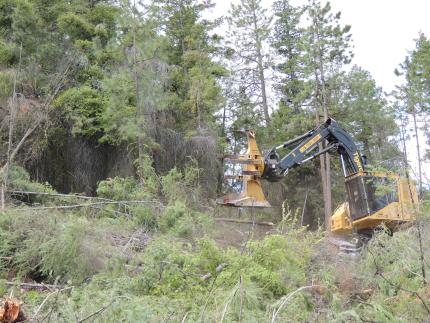
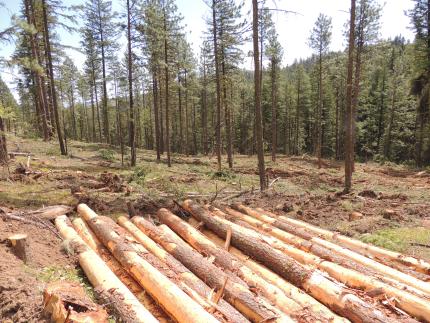
Oak Creek Wildlife Area Weed Spraying: Biologist Charlet, Natural Resource Technician Boggs, and Natural Resource Worker Close have been diligently applying herbicide to Scotch thistle, Canada thistle, knapweed, yellow star thistle across the Oak Creek and Cowiche units. This is all spot treatment via backpack sprayers and all-terrain vehicles.
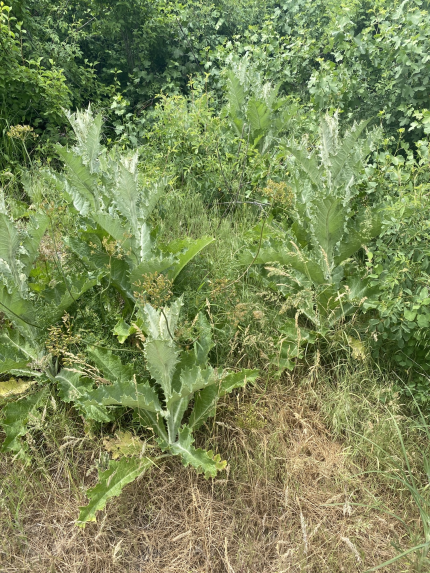
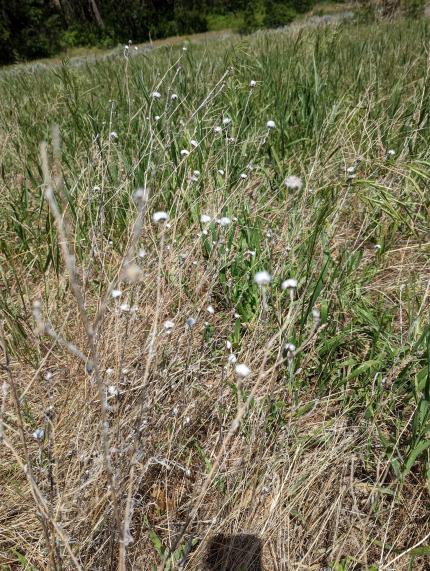
Providing Education and Outreach
L. T. Murray Wildlife Area Kiosk: Assistant Manager Winegeart and Natural Resource Workers Hamlin and Schneider, set five posts in preparation for a volunteer project that will rebuild the large three panel kiosk that burned in the 2022 Vantage Highway fire.
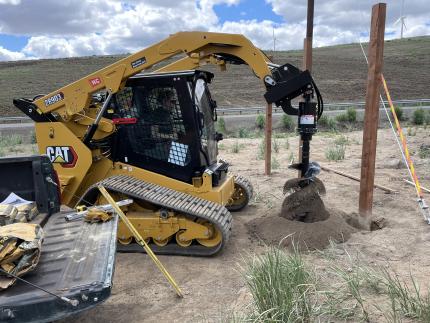
Oak Creek Wildlife Area Volunteer Work Party with the Rocky Mountain Elk Foundation: On May 19 and 20, volunteers with the Rocky Mountain Elk Foundation (RMEF) assisted Oak Creek staff members in the clean-up of a recent 100-acre acquisition along the Tieton River. This was the site of a homesite and small farm. Although, WDFW Capital and Asset Management Program (CAMP) crews removed the larger structures, several small outbuildings remained as well as a small orchard. Volunteers removed and piled the fruit trees, removed three outbuildings, and removed approximately 500 feet of fencing. In total approximately 15 cubic yards of construction debris was hauled to the landfill.
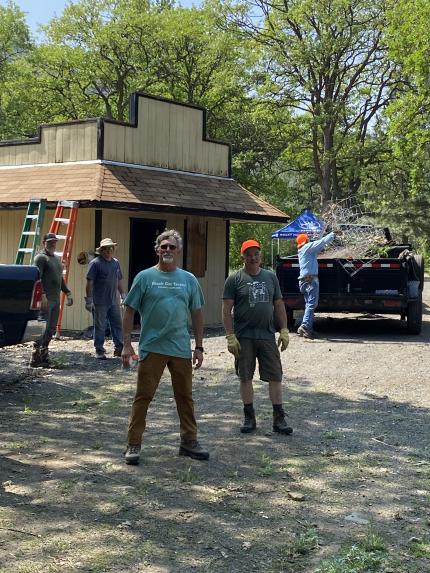
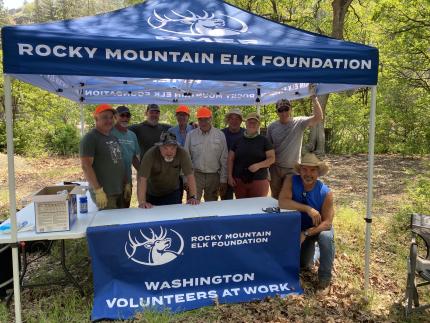
Oak Creek Wildlife Area Signs, Kiosk, and Cattle Guards: Oak Creek staff members began cleaning cattle guards on the Cowiche Unit, along with installing a green dot management sign and kiosk within a recent acquisition to the unit.
Conducting Business Operations and Policy
Unfortunate Change to Providing Technical Assistance to Landowners: Private Lands Biologist Hulett organized all State Acres for Wildlife Enhancement (SAFE) contracts in Region 3 to hand over to the local county Natural Resource Conservation Service (NRCS). As of April 7, 2023, WDFW is no longer the Technical Service Provider (TSP) for any of the SAFE contracts in Washington State. Instead NRCS will be taking responsibility of all SAFE contracts. Hulett passed off all Franklin County SAFE contracts to NRCS on May 25, 2023. They are waiting to pass off Benton County’s SAFE contract documents until they can meet with a representative for Benton County NRCS, but there is currently not an NRCS staff member for Benton County.
Other
L. T. Murray Fence: Assistant Manager Winegeart and Natural Resource Specialist Nass repaired riparian exclosure fence on the Parke Creek subunit of the Quilomene Unit.
Giffon Lake Outflow: In order to maintain water levels and flow in Giffon Lake and surrounding wetlands, Manager Kaelber and Natural Resource Technician Manderbach removed beaver debris and sediment from the Giffon Lake outflow at the Sunnyside Headquarters Unit. The operation required launching a small boat to access the outflow and successfully dislodge the debris.
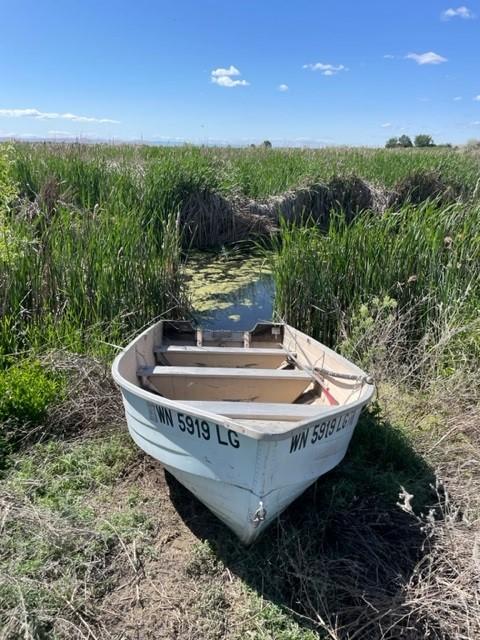
Sunnyside Headquarters Food Plot: Manager Kaelber, Assistant Manager Jahns, and Natural Resource Technician Manderbach seeded several food plots along circle edges at the Sunnyside Headquarters Unit. The crops planted will provide valuable forage for wildlife throughout the entirety of the growing season.
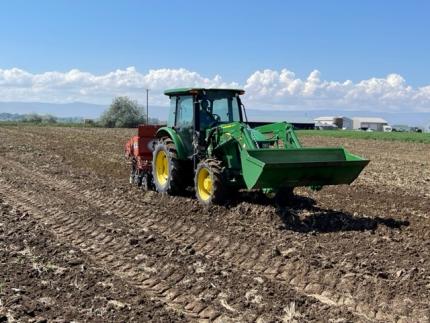
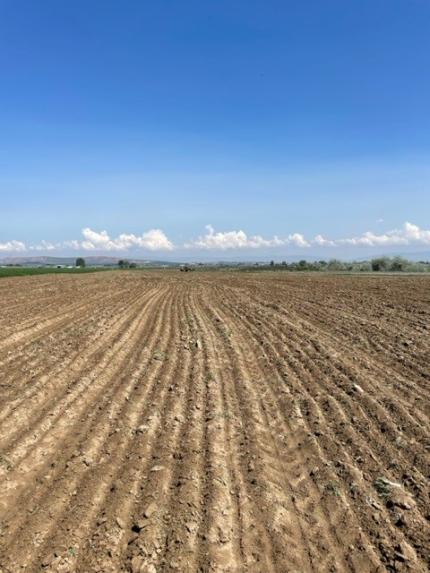
Sunnyside and Snake River Nesting Season: Sunnyside and Snake River staff members have observed a variety of hatchlings and fledglings throughout the wildlife area this spring including great horned owls, barn owls, and several species of waterfowl and shorebirds.
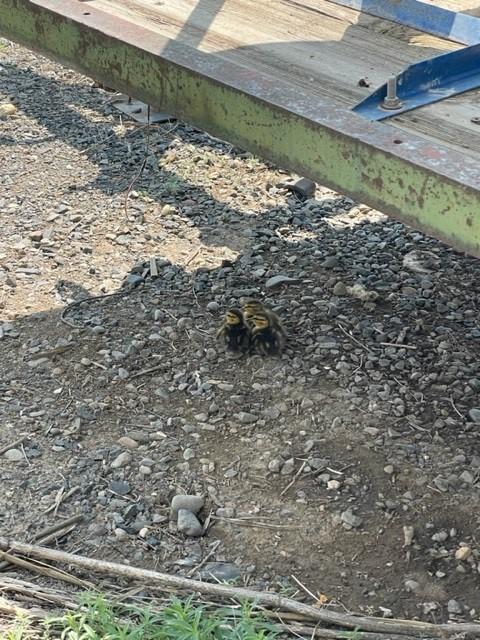
Managing Wildlife Populations
Sooty Grouse Surveys: Region 4 district wildlife biologists completed the first year of surveys for sooty grouse using a protocol developed by Oregon State University and Oregon Department of Fish and Wildlife. Biologists will conduct listening surveys for male sooty grouse along predetermined routes each year from April into May. By listening for the distinctive calls of male sooty grouse, biologists can assess trends in abundance of grouse over time.
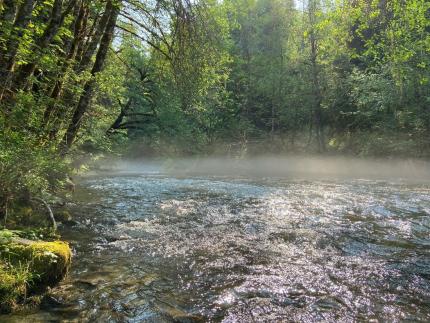
Protected State Wildlife -Peregrine Falcon Climbing Closure in King County: District 12 Biologists Anderson and Smith spent some survey time in the field with volunteers from Urban Raptor Conservancy (URC). A very dedicated member of the URC has been keeping weekly tabs on a very popular King County climbing wall to monitor age and stage of young peregrine falcons. The four eyasses (chicks) should be fledging in the next two weeks. We thank the URC for their extra eyes and survey efforts as it really assists in providing a detailed tab on this and other falcon sites that are under pressure in King County. Appreciation also is extended to the broader climbing community, Washington Climber’s Coalition, State Parks, US Forest Service, and others for support and collaboration in nesting management efforts.
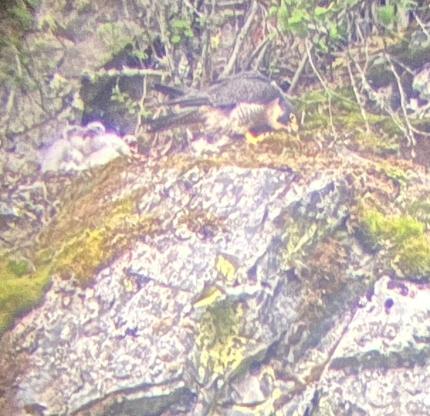
Washington Bat Working Group: There is a new working group that is a subcommittee of the Washington Bat Working Group. They will be examining bat box designs, efforts, outreach, research, and all things related to bat boxes. Biologist Anderson participated in the inaugural meeting.
Washington State Department of Transportation (WSDOT)-Habitat-Wildlife Program Culvert Replacement – Wildlife Considerations: District 12 Biologist Anderson and Waterfowl Biologist Hamer met with WDFW Habitat and WSDOT environmental leads regarding a project in the Grotto area of King County. At this site harlequin ducks, a species of greatest conservation need (SGCN) as outlined in the State Wildlife Action Plan (SWAP), had a history of breeding season loafing and nesting at the site. The project and site were discussed specifically and visited. Due diligence surveys were conducted by the Habitat Program and WSDOT worked on implementation of the culvert replacement. The highlight was discussing consideration of harlequins and other SGCN in relation to other culvert/alteration of waterway projects, such as culvert replacement efforts, moving forward.
Providing Recreation Opportunities
The Region 4 Private Lands Access Program has spent several days this month partnering with Sierra Pacific Industries to remove dumped garbage from properties. Sierra Pacific Industries provides extensive recreational access to general public and additional access for special permit hunters and hunters who access their property through the Hunt by Reservation System. Garbage cleanups are a way to reduce the challenges that come with public access and encourage private timber companies to continue to allow public access. Some of these cleanups can be done by hand, but other require extensive planning and equipment.
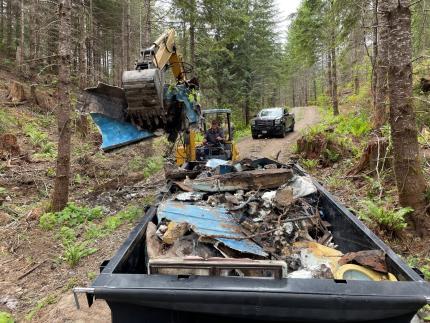
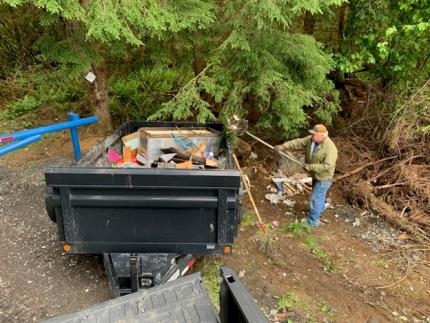
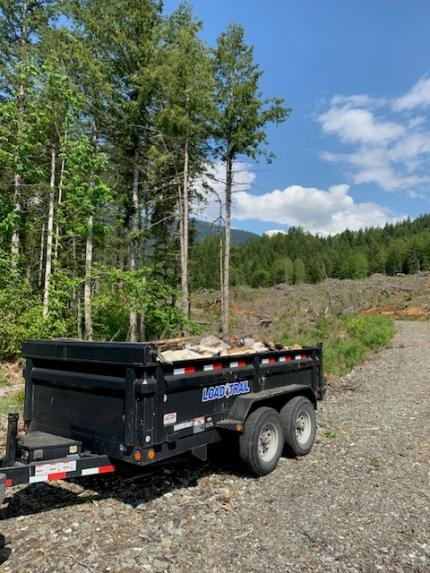
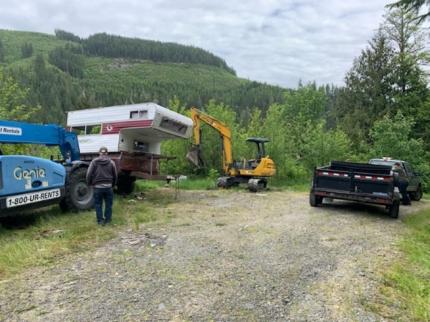
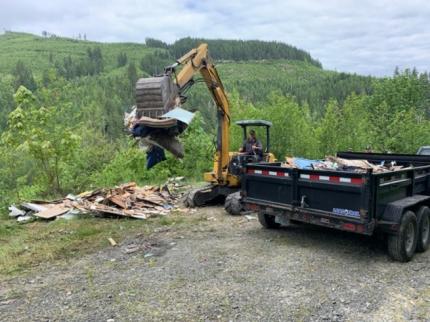
The Region 4 Private Lands Access Program (PLAP) team recently finished planting the Bayview-Edison north and south hunt sites. PLAP has contracted with the landowner to lease 80 acres for waterfowl forage. This property was planted in pasture grass last fall. Over the winter, the sheet water built up and flooded out several zones and waterfowl foraged heavily on the growing grass. This spring in the flooded-out zones, the PLAP team prepared the ground and planted a mix of forage crops for wintering waterfowl that will increase the diversity of food resources on this property and provide more forage for waterfowl. The property is managed for hunting access as well. Washington Migratory Bird Stamp funds were used for this project.
Conserving Natural Landscapes
Restoration Project Coordinator Desmul and Environmental Planner Ballhorn with the Habitat Program spent a sunny morning on Spencer Island in the Snoqualmie Wildlife Area downloading level logger data to measure water temperature, depth, and salinity. The data will be used to help plan a restoration project on site.
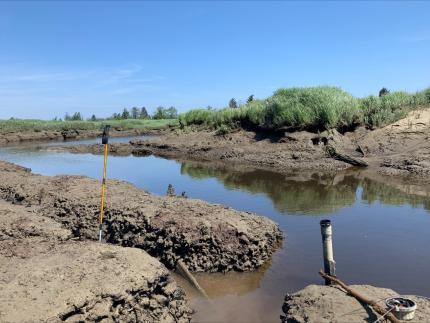
Providing Education and Outreach
Restoration Project Coordinator Desmul and Assistant Regional Wildlife Program Manager Brokaw led two tours of Leque Island in the Skagit Wildlife Area, one for the community group Sound Water Stewards from Island County and one for the Habitat Strategic Initiative.

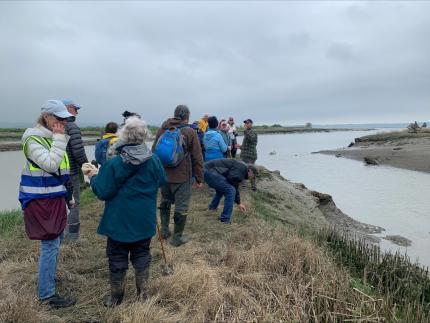
Managing Wildlife Populations
District 9 Sooty Grouse Surveys: Biologists Wickhem and Bergh each drove a different survey route for sooty grouse this month. The surveyor begins a half hour before sunrise and makes a stop every half mile to listen for hooting male sooty grouse. The goal is to perform at least 300 listening stops within each of the Western Washington grouse zones (North Puget Sound, Olympics, and Southwest), with biologists all over Western Washington participating in these surveys. With a sampling rate of 300 stops, we should be able to detect changes in sooty grouse populations, which have not been previously studied in Washington State despite being a popular game species. On their respective routes, Wickhem heard two males sootys, saw one female sooty, and heard two ruffed grouse while Bergh heard one ruffed grouse. Big thanks to District 10 for covering a few District 9 routes and we look forward to learning more about our sooty grouse populations.
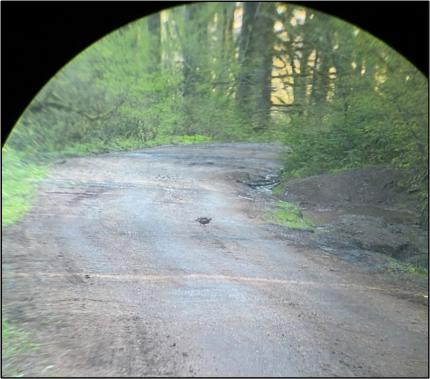
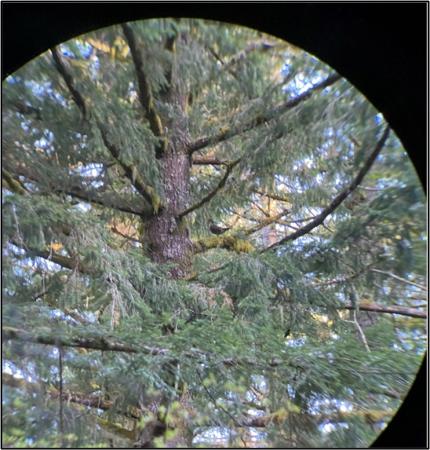
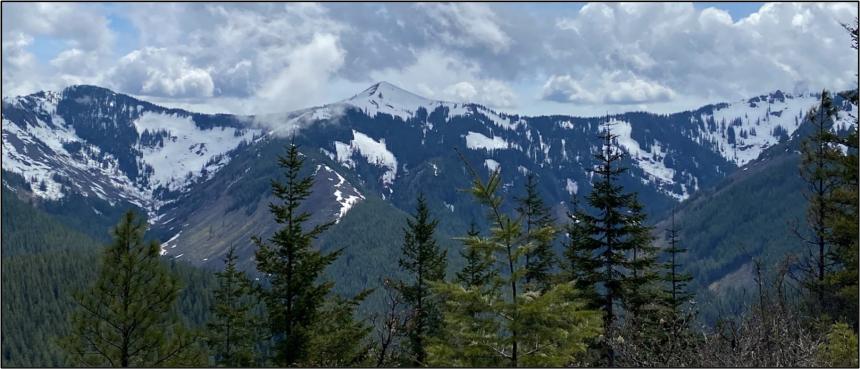
District 10 Sooty Grouse Surveys: Western Washington WDFW Wildlife Biologists are testing a survey method for sooty grouse, formerly called blue grouse. The effort involves establishing driving routes in the Cascade and Olympic Mountains as well as the Willapa Hills. The routes include 15 to 30 listening stops where Biologists spend time listening for the calling male sooty grouse during the early morning hours. The survey method is borrowed from Oregon Department of Fish and Wildlife as well as Oregon State University and we thank them for their development of the method and sharing. When fully developed and implemented, the survey will generate sooty grouse population trend estimates that are independent of grouse harvest. To date, Biologists Stephens and Holman along with Conflict Specialist Aubrey and Cowlitz Wildlife Area Assistant Manager Steveson have completed eight survey routes and done repeat surveys on three of these.
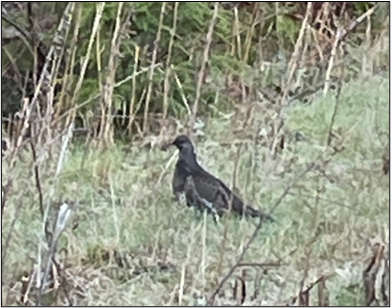
Townsend’s Ground Squirrel Surveys: During April and May, Technician Motiff and Biologists Wickhem and Bergh conducted Townsend’s ground squirrel (TGS) surveys in Eastern Klickitat County. TGS are considered a species of greatest conservation need and a priority species by WDFW and their distribution is not well known in Klickitat County, with only a few historical points currently in our database. The trio, with the help of Habitat Biologists Ritter and Downes, were able to dig up environmental survey reports from several wind companies that were conducted in the mid-2000s, most of which had reports of finding TGS. Approximately 160 previously unknown (to WDFW) TGS locations were gathered from these reports, and the team was able to obtain landowner permission and survey 130 of those locations. Unfortunately, TGS presence was confirmed at only seven of those points, but that is still six more TGS colonies than were known to exist in Klickitat County before surveys began. The team looks forward to future TGS surveys and finding more of these elusive critters.
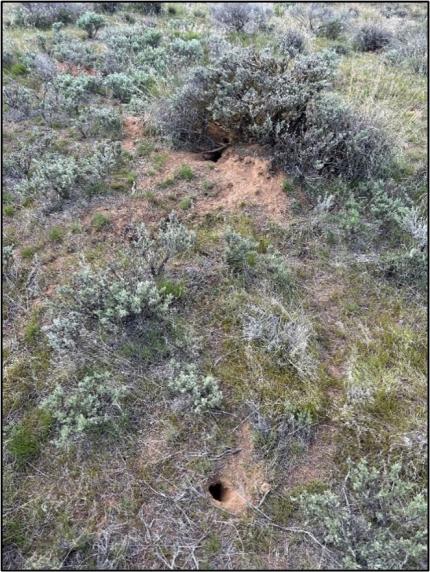
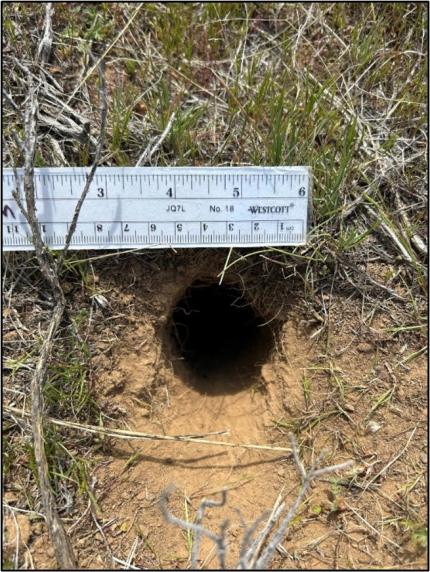
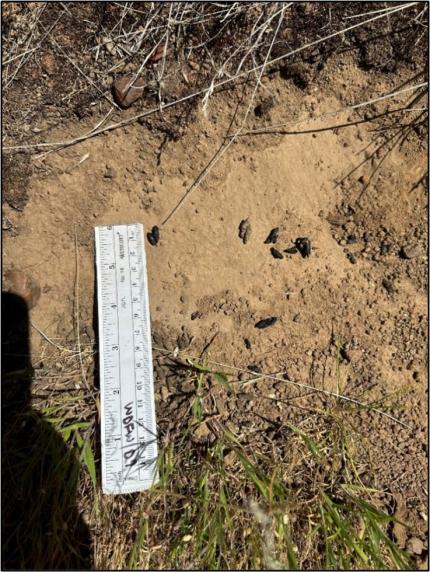
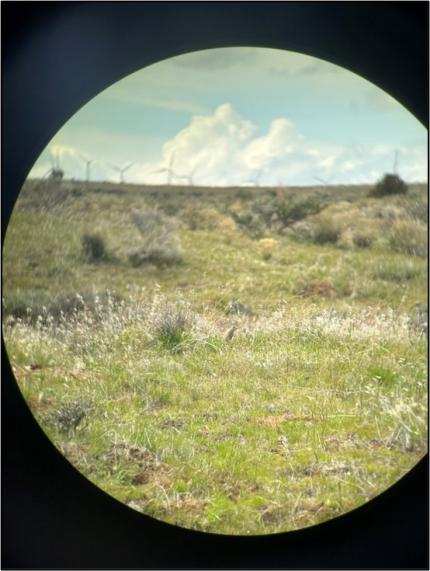
Headstart Turtle Notching: Biologist Wickhem and Technician Motiff visited the headstarted northwestern pond turtles at the Oregon Zoo this week. The turtles were brought to the zoo as hatchlings in May 2022. Under the care of zoo staff, they can grow larger in a safe setting and be released back into their natural habitat at a size that allows them to more easily avoid predators. Wickhem and Motiff assigned these headstarted turtles identification numbers and put notches in their shell scutes using a triangle file. These notches do not harm the turtles and will help staff identify these individuals the next time they are captured in the field. Wickhem and Motiff also took weights, shell measurements, and checked tags on all the headstarts. These turtles will be released at a site in Skamania County in late May.
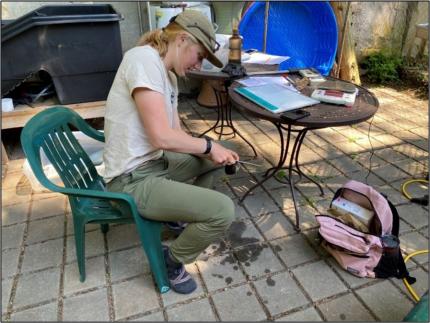
Klickitat Mule Deer Mortality Investigation: Biologist Wickhem investigated two collared deer mortalities in the second half of May. For the first, Wickhem and Yakama Nation Wildlife Technician Heemsah responded to a mortality signal from a collared mule deer doe that died on the Yakama Reservation. Unfortunately, when the pair arrived it appeared the doe had been dead for several days and all they could find was the collar, one ear tag, a bunch of deer hair, and a few bone fragments, making it impossible to determine the cause of death.
For the second deer, the collar began sending the signal over the long holiday weekend. After looking at its most recent GPS locations, it appeared the deer had not moved for several weeks. To reach the carcass, Wickhem side-hilled through poison oak in a side canyon of the Klickitat River and had the assistance of at least 12 ticks on her journey. Despite being dead for a significant period of time, what was left of the carcass (bones and leathery skin) was still partially buried in a cache, and an old drag mark and feline scat were found nearby, so the doe was likely killed by a cougar. These deer are part of a four-year study being conducted throughout Game Management Unit (GMU) 388 and GMU 382 to track the annual movements of female mule deer and locate important migration corridors. Staff members are also attempting to determine cause of death when an animal dies, which has proven to be difficult. In winter 2021, 81 collars were deployed throughout the GMUs for this effort. Twenty collars were deployed in the winter of 2022 and 23 were deployed in the winter of 2023, most of which were redeployments replacing study deer that died over the first two years of the study. We are nearing the end of the study so these collars will not be redeployed for this project.
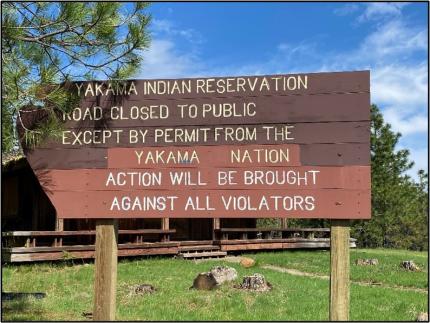
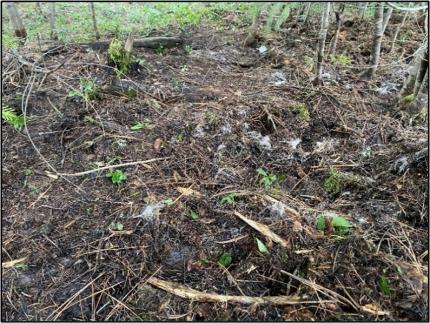
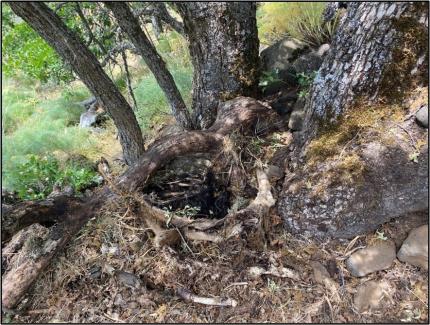
Bat Guano Collection: In mid-April, Biologist Wickhem installed bat guano collection trays at a residence in Washougal that has numerous well-used bat boxes. Using a new technique, biologists can test fresh guano for Pseudogymnoascus destructans (Pd), the fungus that causes white-nose syndrome. This method has proven to be effective, and collection does not disturb the bats, which can be a problem with some other sampling methods. In mid-May, Biologist Wickhem and Technician Motiff returned to the residence to collect the guano and remove the collection trays. The guano will be frozen and sent to the lab for testing.
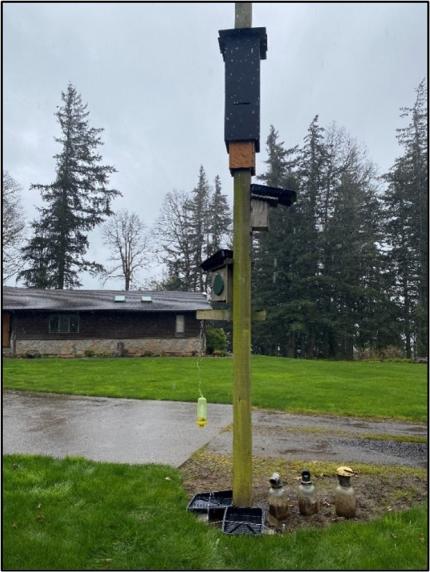
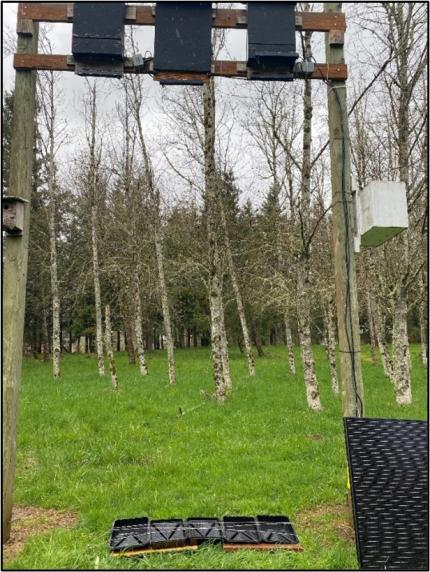
Turtle Barrier Construction: WDFW staff members, Master Hunter volunteers, and Underwood Conservation District staff members worked on construction of a barrier designed to prevent turtles from crossing a paved road with a 50-miles per hour speed limit. The project is on private land and was funded by WDFW as well as the Partners for Fish and Wildlife program. A trencher was used to dig a trench and hardware cloth was partially buried underground. Above ground, it was attached to U posts and included a “lip” at the top to prevent turtles from crawling over it on the side that would lead them to the road, but will allow them to crawl up and over and jump down on the side next to the road.
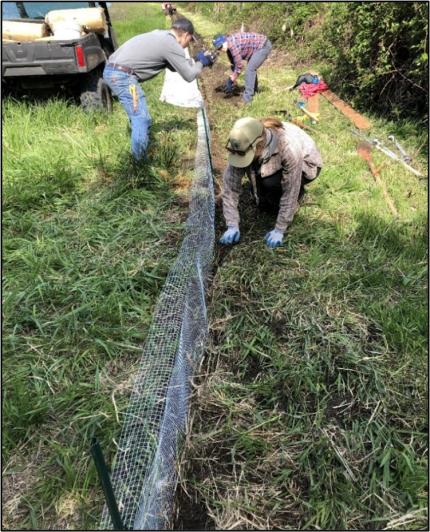
Turtle Releases: Two different groups of northwestern pond turtles were released back into their ponds this week. One group of mainly adult female turtles was captured last August, received treatment for shell disease at the Oregon Zoo and PAWS last fall, and spent the winter rehabilitating at Larch Correctional Center. These turtles were assessed by the Oregon Zoo veterinarian to be ready for release and were returned to their ponds with the help of the Sustainability in Prisons Program turtle coordinator. The second group of turtles released this week were captured last May as hatchlings (about the size of a silver dollar coin) and sent to the Oregon Zoo to be headstarted to a size that can help them avoid predation by non-native bullfrogs. Normally these turtles would hibernate over the winter, but instead are cared for by the zoo. Video can be seen here.
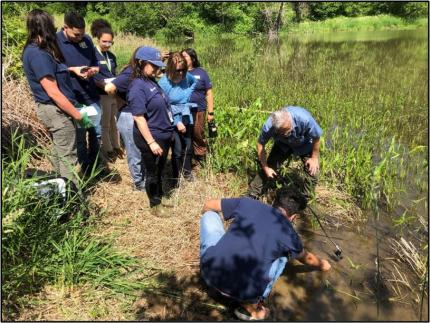
Bat Exclusion and Bat House Placement: Biologists Holman and Stephens attempted to exclude bats from a shop used by Wildlife and Enforcement programs. In addition to the entrance of choice used by the bats, a bat house was mounted on the same side of the shop. Over the past couple of years, bats have been using the shop as a night roost in the summer months and the guano has made a mess on the equipment stored inside. Biologists are hopeful that the bats will find the new home to be a satisfactory replacement.
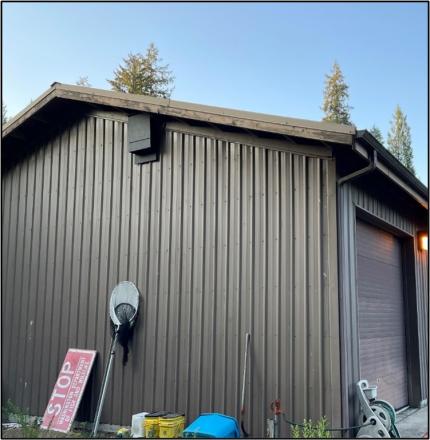
Providing Recreation Opportunities
Memorial Day Weekend on the Klickitat Wildlife Area: Wildlife Area Manager VanLeuven and Assistant Manager Hunt visited with campers on the Soda Springs Unit on May 27 to provide information and check on compliance with rules. Surprisingly few people were recreating on the wildlife area compared to previous years. Reminders were given to people who did not have Discover Passes for their vehicles. Assistant Manager Hunt found evidence that someone has driven a motor vehicle into a nonmotorized assess area which has become a persistent problem recently. She also observed a camp that had an open fire in violation of the seasonal ban on campfires.
Klickitat Wildlife Area Soda Springs Unit Road Maintenance: WDFW’s road maintenance crew worked on the Klickitat Wildlife Area Soda Springs Unit, grading and adding rock to the surface of two main roads. Rain on the next day helped to settle the rock in place. They will work on the wildlife area for about one more week before they move on.
Providing Conflict Prevention and Education
Cougar Depredation on Goat: A concerned landowner contacted Wildlife Conflict Specialist Jacobsen to report a cougar depredation on his goat in Clark County. Unfortunately, the landowner waited several days to report the incident and had already disposed of his goat. Jacobsen provided advice on securing the landowner’s remaining goats in an enclosed night pen, setting up additional deterrent measures, and asked the landowner to call back if the cougar was observed again.
Residential Deer Damage: A homeowner contacted Wildlife Conflict Specialist Jacobsen to complain about deer damage to his ornamental plants around his residence. The homeowner’s neighbors have been feeding the deer which was contributing to the problem. Jacobsen provided resources to the homeowner about deterring deer damage and how deer feeding is detrimental to deer. The homeowner plans to distribute that information to his neighbors and speak to the community council about the issue.
Farm Visit: Wildlife Conflict Specialist Jacobsen followed up with a landowner who had captured a bobcat on camera near her livestock. Jacobsen performed a site visit and provided advice to the landowner on how to better secure her abundant livestock from cougars, bears, and bobcats.
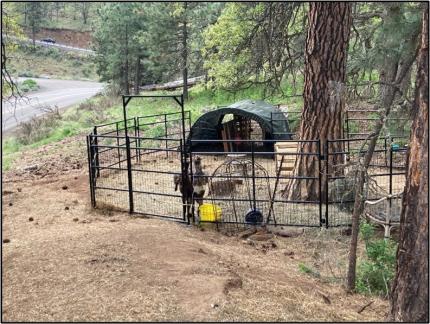
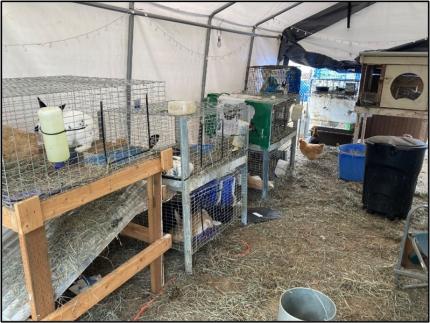
Deer Damage to Vineyard and Chestnut Trees: Wildlife Conflict Specialist Jacobsen and Technician Kolenberg met with two neighboring landowners who have been experiencing deer damage to vineyards and to a new planting of chestnut trees. Cooperative fencing projects were discussed.
Deer Damage to Cherry Orchard: Wildlife Conflict Specialist Jacobsen was contacted by an orchard owner regarding deer damage to newly planted cherry seedlings. The owner recently invested $40,000 in new seedlings as part of his larger orchard. Jacobsen met with the landowner and will enroll the landowner in a Damage Prevention Cooperative Agreement. Several deterrent measures were discussed and a cooperative deer fencing project may also be in the landowner’s future.
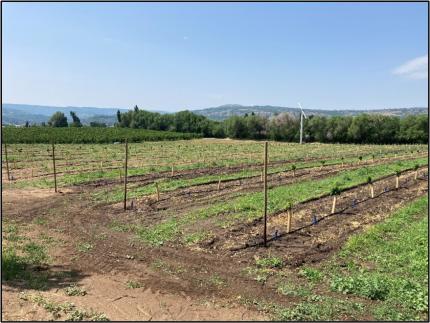
Bear Conflicts: Over the last several weeks, Wildlife Conflict Specialist Jacobsen and Technician Kolenberg have fielded and responded to dozens of bear conflict calls. Jacobsen has been noticing an increase in the frequency of “bear in chicken coop” calls compared to previous years, which may likely be due to an increase in the number of rural and suburban residents keeping unsecured chickens in their yards. While initially problematic, the vast majority of bear-chicken coop conflicts can be easily solved by changing how chicken feed is stored and by adding a few strands of electric fencing to existing chicken coops. Additional bear calls included scenarios related to bears accessing garbage, bird food, and outdoor grills. In all instances, Jacobsen and Technician Kolenberg provided advice on bear biology, securing additional attractants, and on proper and effective means of installing electric fencing.
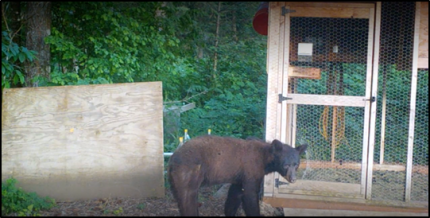
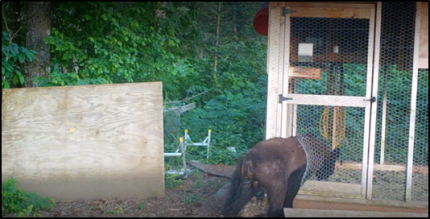
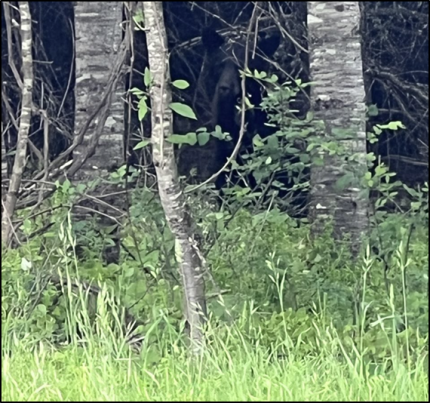
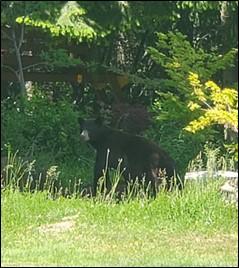
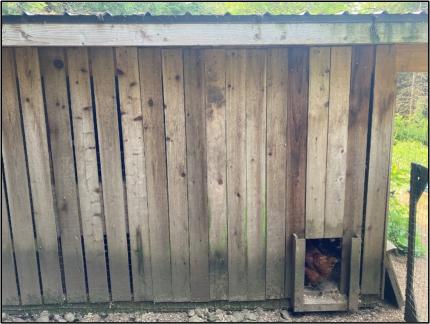
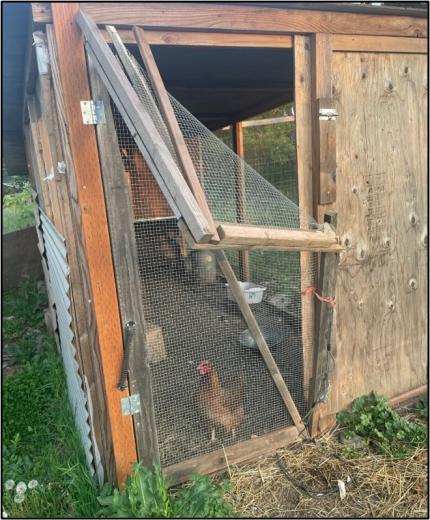
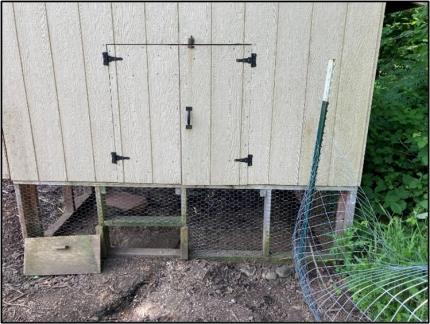
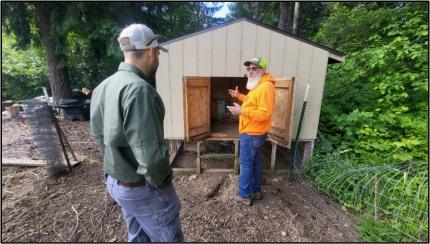
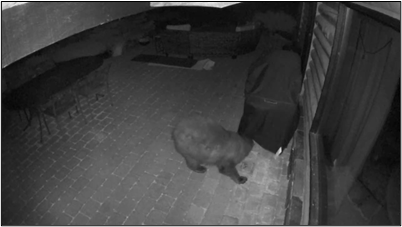
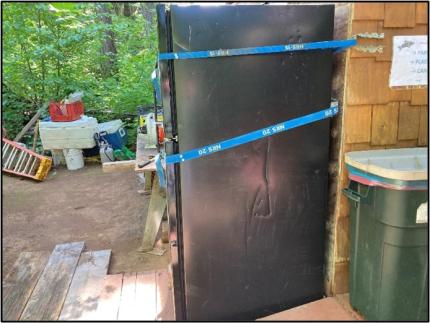
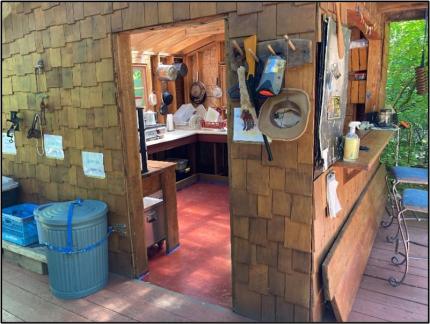
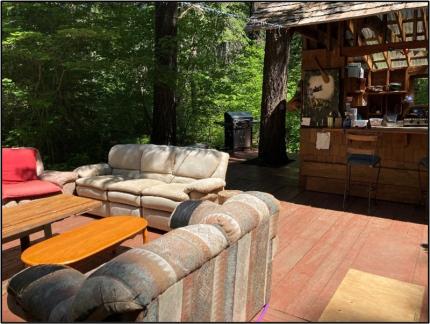
Snake Concerns: Wildlife Conflict Specialist Jacobsen fielded a phone call from a landowner who was concerned about a snake in her yard. The landowner believed that the snake was a western diamondback rattlesnake. The landowner sent a photo of the snake to Jacobsen, who confirmed it to be a Pacific gopher snake, also known as a “bull snake”. Jacobsen provided advice on living with snakes.
Livestock Carcass Disposal: Wildlife Conflict Specialist Jacobsen hauled deceased livestock carcasses from cattle operations to the local landfill to help prevent scavenging by wolves near live cattle.
Injured Osprey: A concerned citizen brought an injured osprey to Wildlife Conflict Specialist Jacobsen’s residence after she picked it up off the side of Highway 14 in Klickitat County. Jacobsen assessed the osprey and determined that the extent of its injuries was too great to make it a candidate for rehabilitation. Jacobsen euthanized the osprey.
Fawn Kidnapping: Wildlife Conflict Specialist Jacobsen responded after-hours on Memorial Day weekend to a report of a fawn that was picked up from alongside a road by a citizen, separated from its mother and sibling, and dropped off with a random person roughly 20 miles away. Jacobsen, along with Officers Myers and Way, spent a considerable amount of time trying to locate the original “fawnnapper” to determine where the fawn came from. The “fawnnapper” was too intoxicated at that point to drive to the location where he picked it up that morning, so he provided a rough description to Jacobsen of the location over the phone. Once the fawn’s origin location was determined, Jacobsen drove to the residence where the fawn was being held and took possession of the fawn. Jacobsen released the fawn in the approximate location where it was stolen from. The fawn’s chances of survival were low, given the amount of time that had elapsed from when it was stolen. Had Jacobsen not been able to determine the location where the fawn was stolen from, he would have had to euthanize the otherwise healthy fawn. There are currently no rehabilitation options for fawns in Klickitat County, which is one of the reasons why it is critical for citizens (regardless of what county they are in) to report their concerns to WDFW rather than attempting to help a fawn on their own by picking it up.
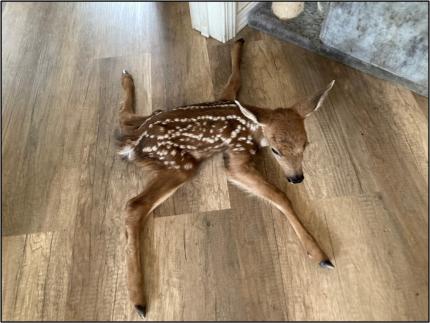
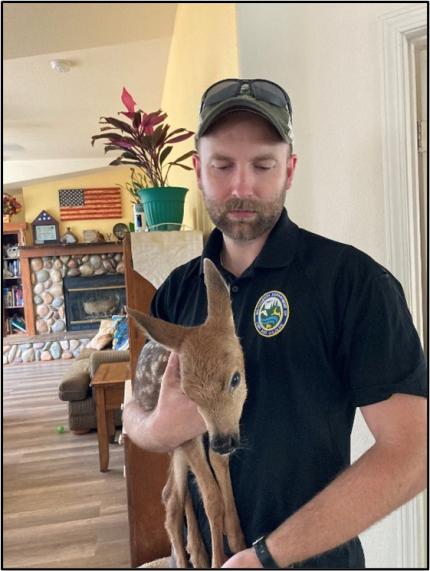
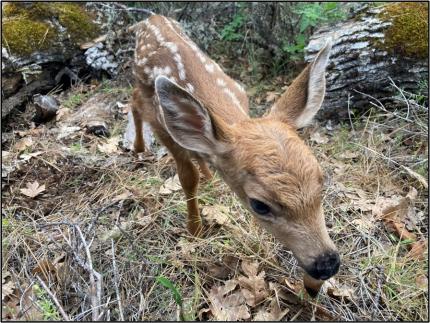
Injured Bald Eagle in Kelso: Wildlife Conflict Technician Kolenberg responded to a report of an injured bald eagle in the reporting party’s yard off Rose Valley Road in Kelso. Kolenberg caught and secured the eagle. He transported the eagle to a rehabilitator.
Black Bear and Beehives in Southeast Chehalis: Over the past few weeks, there have been reports of a black bear getting into garbage and birdfeeders in southeast Chehalis. Wildlife Conflict Specialist Aubrey and Technician Kolenberg coordinated to visit the neighborhood where the bear damage was being reported. Technician Kolenberg knocked on doors and handed out literature pertaining to securing food attractants and living in bear country. Technician Kolenberg talked to nine homeowners. The next day, a report came in about a bear damaging two beehives in a nearby neighborhood. Technician Kolenberg responded to the homeowner and loaned and installed an electric net fence to protect the beehives temporarily until a permanent electric fence could be installed. Technician Kolenberg enjoyed his time installing the electric fence and talking to the homeowners' kids and grandchildren about living in bear country.
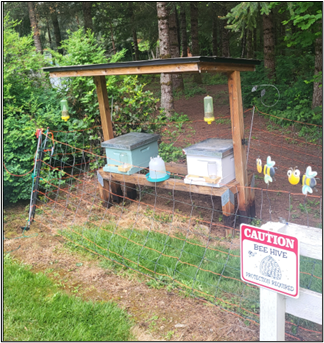
Deer Agricultural Damage in West Chehalis: Since April, Wildlife Conflict Specialist Aubrey and Technician Kolenberg have been working with a landowner with deer damage to his grain crop. Conflict Specialist Aubrey provided landowner cracker shells to help haze deer out of the grain fields. Kolenberg loaned and installed the propane cannon adjacent to the grain field to haze the deer. Kolenberg checked in with the landowner over the course of a few weeks and picked up the propane cannon. The landowner said he did not need it anymore, and it was successful in keeping the deer away until his crop grew taller. The landowner said he was able to save 80% of his crop and was very thankful for our help.
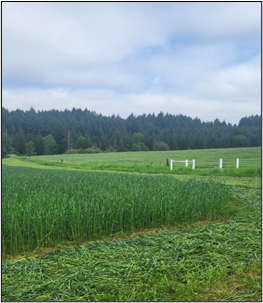
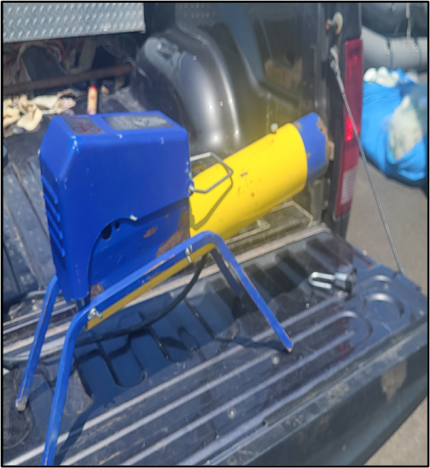
Injured Eagle: Wildlife Conflict Specialist Aubrey responded to a report of an injured bald eagle in Lewis County. After arriving at the reported location, Aubrey spotted the eagle on the adjacent property. The eagle was captured and observed to be blind in one eye. The eagle was taken to a rehabilitator for further evaluation.
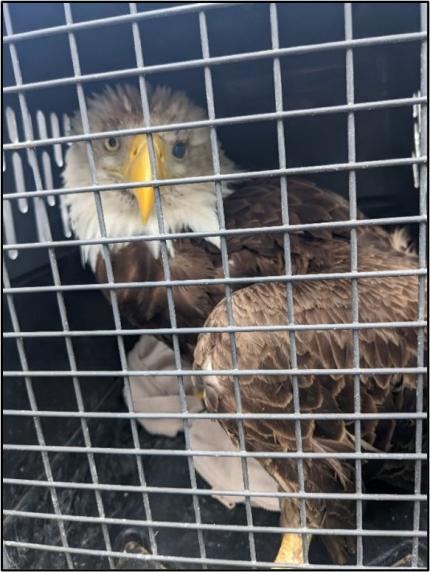
“Fawnapping” Part II: Wildlife Conflict Technician Kolenberg responded to a call from the Cowlitz County Humane Society in Longview regarding a deer fawn that was dropped off. This call was almost identical to Wildlife Conflict Specialist Jacobsen’s deer fawn call later that day! The Humane Society reported that the deer fawn was dropped off that morning by an individual who appeared to be intoxicated. The person did not tell the staff where they found the deer and left the scene. Technician Kolenberg picked up the deer and had to euthanize it since no location was given where it was initially taken, and deer cannot be moved across regional boundaries.
Conserving Natural Landscapes
Tour of Soda Springs Unit of the Klickitat Wildlife Area Forest Health Enhancement Project Units 4 through 9: WDFW Forester Mize led a tour of the planned timber thinning project area on the Soda Springs Unit. The tour was attended by representatives from the Yakama Nation Natural Resources Division, Washington Department of Ecology, Washington Department of Natural Resources, archaeologists from WDFW and the Yakama Nation, Forest Management Team Lead Richard Tveten, WDFW Forester Lauffer, and Klickitat Wildlife Area management staff. The tour began with a walk through one of the units thinned in 2018 so the group could see the results of that work five years after the treatment. Next, the group moved to Unit 4, which is one of the units to be thinned in fall 2023. This unit has a varied forest composition including some large legacy trees and old snags interspersed with oak woodlands. The areas of pure oak woodland are excluded from the thinning project. The group moved on to Unit 7, which is on a drier site and features smaller conifers mixed with oak. All the units are occupied by western gray squirrels, and the nest trees have been marked for retention along with a 25-foot diameter no-cut buffer around the nest trees to protect the most important habitat for squirrels. Units 1, 2, and 3 were thinned according to the same prescription in 2018, and the success of that work demonstrated the utility of the treatment in achieving the desired results.
Seasonal Burn Ban in Effect: On May 15, the seasonal ban on open fires went into effect on the Klickitat Wildlife Area. This annual ban is a precautionary measure to reduce the risk of fire escapement and uncontrolled wildfire. It extends from May 15 through Oct. 31. The exceptions to this burn ban interval are the Leidl Park, Stinson Flat, Mineral Springs, and Turkey Hole campgrounds along the Klickitat River, which are on the same burn ban schedule as Klickitat County Zone 2. The burn ban for Zone 2 begins on June 5 this year.
Klickitat Wildlife Area Master Hunter Volunteer Project: Three volunteers from the Master Hunter Program came to the Klickitat Wildlife Area to remove old, derelict fences on the Soda Springs Unit this week. These old fences are no longer needed or maintained and can pose a hazard to wildlife, so taking down the strands of barbed wire is an ongoing priority for the wildlife area. Assistant Manager Hunt scheduled two days of work and volunteers Ailanjian, Afflerbaugh, and Strange signed up for both days. The first day they worked near Old Headquarters and the Soda Springs Road to pull out 540 yards of wire, and on the second day they worked near the east property line south of the Soda Springs Road to pull out another 1,220 yards of three-strand fencing. All together this group removed a mile of old fencing. Wildlife Area Manager VanLeuven and Assistant Manager Hunt greatly appreciate the good work done by these gentlemen.
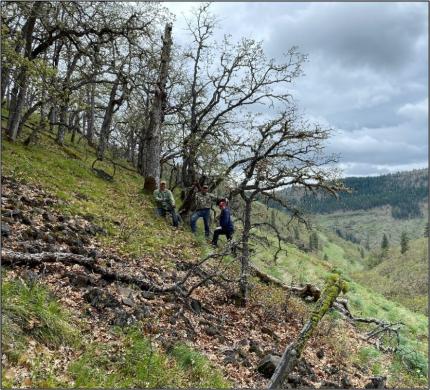
Private Lands Access Program Clean-up: Private Lands Biologist Gray organized the removal and site clean-up of an abandoned boat located at a property enrolled in the Private Lands Access Program. Department of Ecology helped to fund the clean-up effort and staff assistance was provided as a benefit of program enrollment. The landowner was pleased with the outcome.
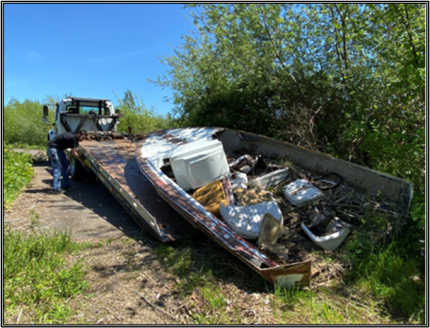
Providing Education and Outreach
Agriculture and Forestry Presentation: Biologist Holman gave a presentation to “Class 44” of the Natural Resources Professional Group AgForestry at their triannual gathering in Cowlitz County. The title of the presentation was “Mt. St. Helens Elk 1980-2020, Relationships Among Forest Succession, Elk Habitat, Productivity and Disease”. Thanks to AgForestry for incorporating wildlife management into their natural resource leadership curriculum and inviting WDFW to present.
Threatened and Endangered Species Presentation: Biologist Stephens and Fisheries Biologist Olk gave a presentation to approximately 80 4th grade students at Chinook Elementary School in Vancouver. The presentation centered on Washington State Threatened and Endangered Species, what threats cause species populations to decline, and how wildlife researchers and managers work to recover these species. The presentation kicked off a new learning module for the students and they had many great questions. Chinook Elementary will be sharing their final projects with WDFW.
Managing Wildlife Populations
Sooty Grouse Population Monitoring: Biologist Tirhi spent some time in May establishing the district’s assigned sooty grouse survey routes. District 11 has four routes to establish and monitor for 2023 (each route having 15-30 listening stations) and three acoustic monitors to deploy. All District 11 routes for 2023 are on Weyerhaeuser property in Game Management Unit (GMU) 667. The routes take a considerable amount of time to establish since each must incorporate an assigned starting location. Forest roads must be investigated for accessibility, permanent listening stations must be established 0.05 miles apart from each other, acoustic monitors must be deployed in secure locations, and logistics of forested locations must be dealt with (snow, clearing downed trees, closed road, etc.). To date, District 11 has established three of the four routes and deployed two of three monitors with plans to conduct actual surveys on the routes the remainder of May and into June.
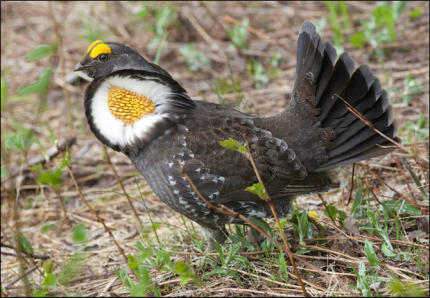
Sooty Grouse: Biologist Cent established a snow-free sooty grouse survey route and completed one survey, just before the end of the survey period.
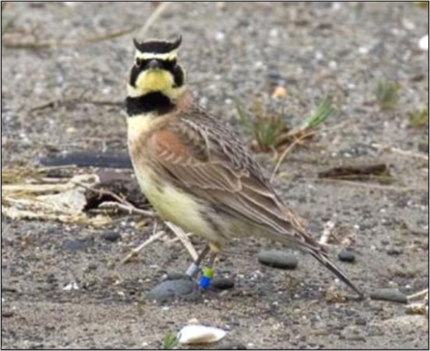
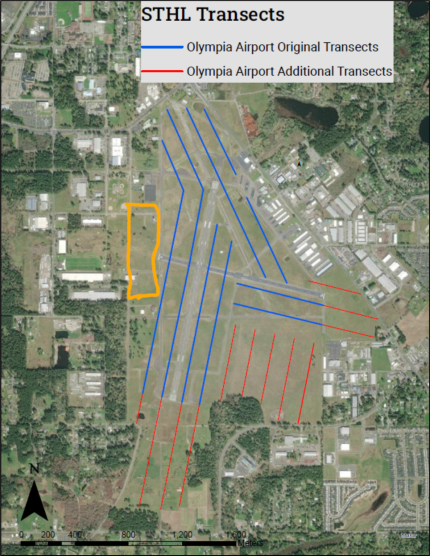
Streaked Horned Lark: Biologists Tirhi and Butler completed collecting the first and second of three surveys of state and federally listed streaked horned lark at the Olympia Airport. The airport is one of the four remaining breeding locations for larks in the South Puget Sound. Tirhi reported 16 observations of individual birds (Butler's totals are not available at this time) which appear to be stable compared to the last count conducted in 2020. Butler and Tirhi added additional survey area for the first time this year such that all grasslands at the Olympia Airport were now included in the survey. These extended areas have traditionally not contained breeding larks and so were left out of previous surveys for expediency of meeting survey protocol timelines. Surveys should begin within half hour of sunrise and end by 11:00 a.m. or earlier on 80-degree days. The extended surveys added significant time to the survey which took the team almost nine hours to complete! This also took the survey outside of the protocol ending timelines; this contingency was approved by our Science Lead Pearson when necessary. Tirhi concluded that a third observer will be necessary to complete future surveys closer to established protocol.
Streaked Horned Lark: Biologists Cent and Novack completed initial surveys for streaked horned lark at various sites. Larks were plentiful at Midway Beach.
Snowy Plover: Biologists Cent and Novack with assistance from other WDFW and non-WDFW staff members completed surveys for western snowy plovers on Washington beaches in conjunction with the range wide surveys conducted in Oregon and California. Final numbers are pending but appeared to be low at Midway Beach and Leadbetter Point.
Band-Tailed Pigeon: Biologists Novack and Cent went to District 16 to establish a pair of trapping sites for band-tailed pigeons. The two landowners kept the traps open and baited for a number of days until Biologists Novack, McMillan, Hamer and Section Manager Spragens were able to conduct captures. Nine birds were caught at Clallam Bay and the team attached three transmitters. An additional three transmitters will be attached at a later date.
Conserving Natural Landscapes
Union River: Noxious Weed Coordinator Heimer and Wildlife Area Manager Laushman toured the Theler Wetlands in Belfair with weed specialists from the Mason County Noxious Weed Board to plan for future invasive species treatment in the area.
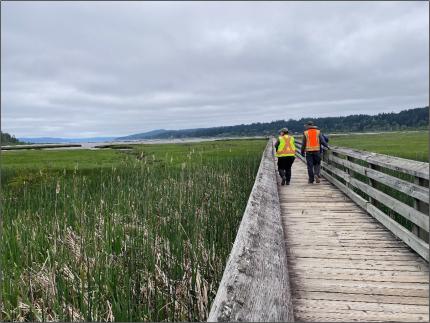
South Puget Sound Volunteer Event: The Clover Park Rotary Club coordinated their biannual community workday at the South Puget Sound Unit. Volunteers helped weed and mulch the native garden, add boundary blocks, and pulled Scotch broom.
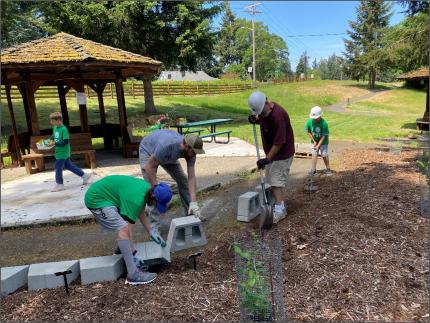
Discovery Bay Visit: Forest Specialist Tveten and Wildlife Area Manager Laushman met with staff members from the North Olympic Salmon Coalition (NOSC) to discuss forest health conditions in the Discovery Bay Unit. NOSC has helped to plant native riparian habitat on the unit along Snow and Salmon creeks for the last two decades, and now are considering how best to treat the growing stands. Tveten advised the group on thinning methods and tree health.
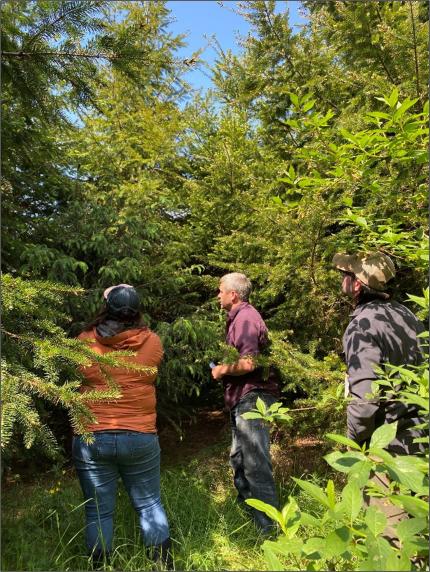
Scotch Broom Bio-Control Release: In early May, the Olympic Wildlife Area staff members employed a new approach in controlling Scotch broom, the release of 600 Bruchidius villosus, also known as the Scotch broom bruchid. The bruchid, a type of bean weevil, was first approved by USDA and released in the Pacific Northwest in 1998 to limit seed production of Scotch broom. The female bruchid will typically lay about ten eggs on the seed pod of the plant. The larva then hatches from the egg at the point it is attached to the pod and burrows into the pod, where it develops and feeds on the seeds. Once a population is established, usually taking about three years, seed pod attack rates are expected to be highly variable (10-90%) as is seed destruction (20-80%). Like all bio-controls this insect alone will not eradicate Scotch broom, but in this case, it will hopefully become a contributing factor in preventing it from spreading.
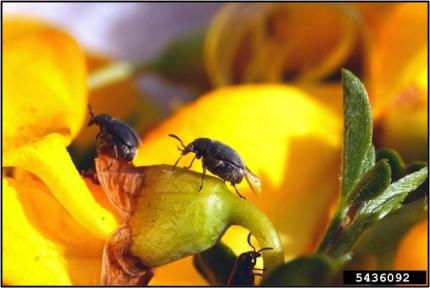
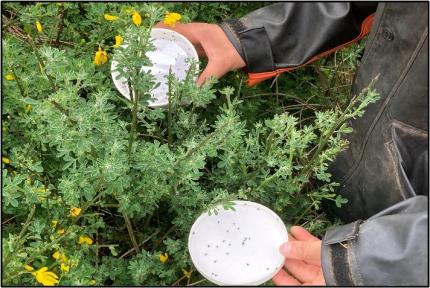
Lands 20/20 Proposals: Biologist Novack presented a number of proposals to Lands Division and other regional staff members for potential inclusion in the upcoming Lands 20/20 cycle.
Conducting Business Operations and Policy
Onboarding: Biologist Tirhi completed required checklist for onboarding Seasonal Technician Sharpe, including having her complete the required training and policy reviews. District 11 is excited to have Sharpe onboard to assist with western pond turtle monitoring, Oregon spotted frog water hydrology monitoring, and other ad hoc district tasks.
Equipment Inventory: Biologists Novack and Cent completed their equipment inventory for the year.
Other
South Puget Sound: The Ecosystem Services Division from the Habitat Program conducted a field visit and meeting at the South Puget Sound Unit in Lakewood. Wildlife Area Manager Laushman and Biologist Butler presented their work in the area to the group and walked the unit together.
